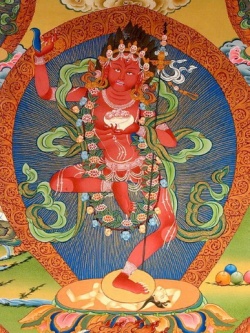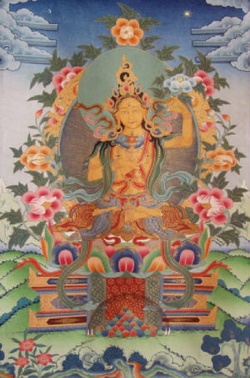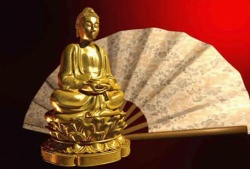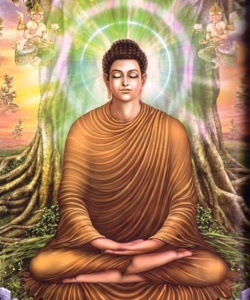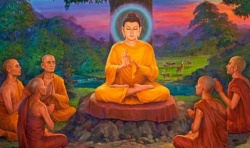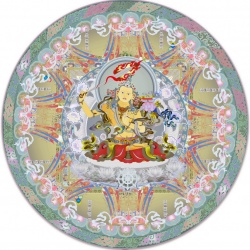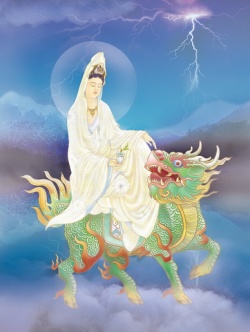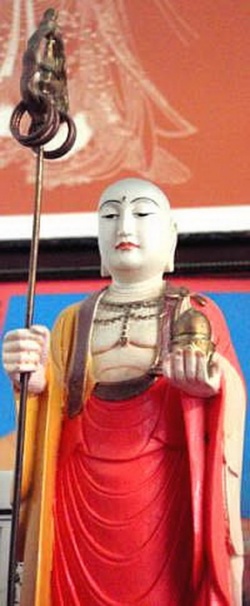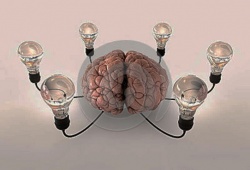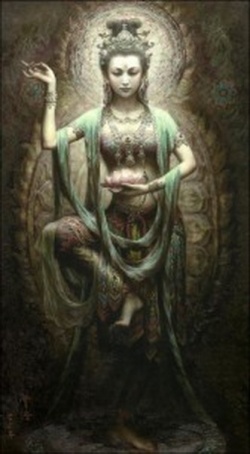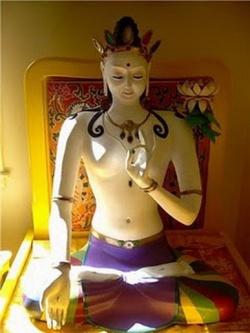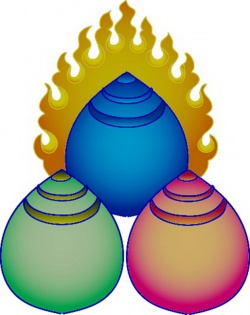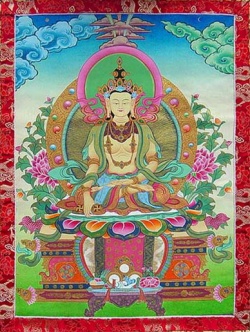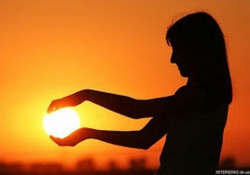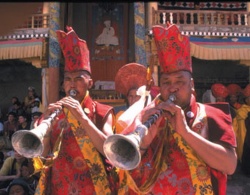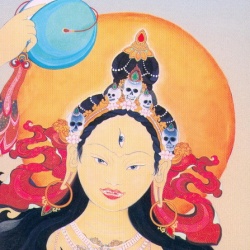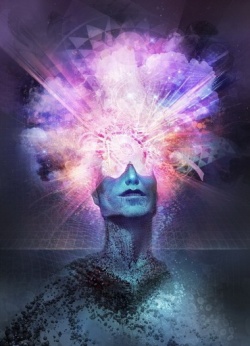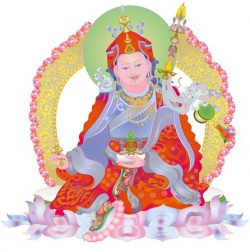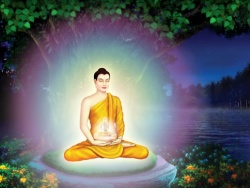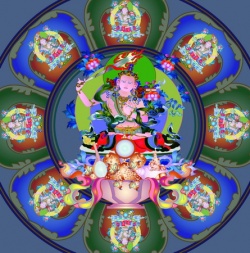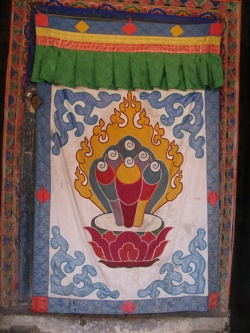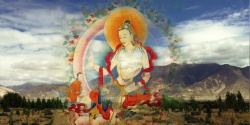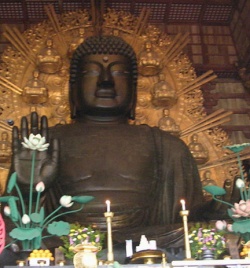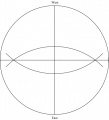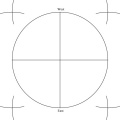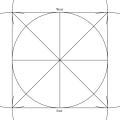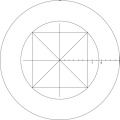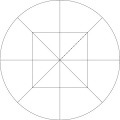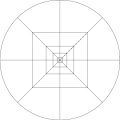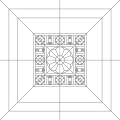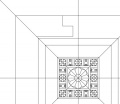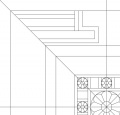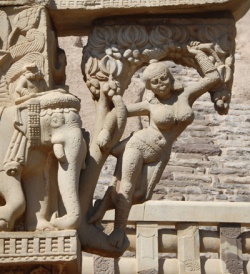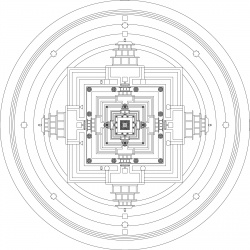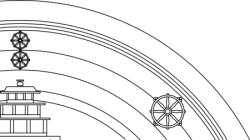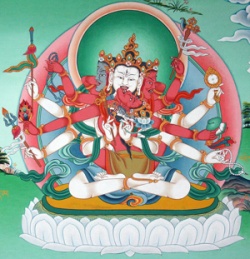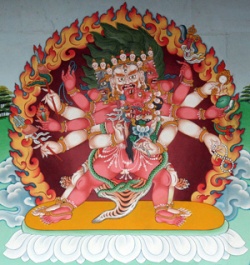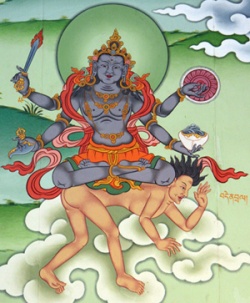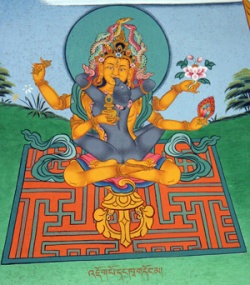Difference between revisions of "The Kālacakra maṇḍala according to the Vajrāvalī of Abhayākaragupta"
(Created page with "thumb|250px| ==1. Drawing the maṇḍala== Perhaps the most important of the original Indian sources on the drawing of the Kālacakra maṇḍala, and ...") |
m (Text replacement - "first stage" to "first stage") |
||
| (24 intermediate revisions by 4 users not shown) | |||
| Line 1: | Line 1: | ||
| − | + | {{DisplayImages|921|1218|492|45|485|1843|197|1506|923|1968|346|640|620|1011|895|1007|391|231|575|1410|240|413|672|1364|1427}} | |
| − | ==1. Drawing the maṇḍala== | + | ==1. Drawing the [[maṇḍala]]== |
| − | Perhaps the most important of the original Indian sources on the drawing of the Kālacakra maṇḍala, and one that is important to all the Tibetan traditions, is the Vajrāvalī-nāma-maṇḍalopāyikā (dkyil 'khor gyi cho ga rdo rje phreng ba) of Abhayākaragupta, an abbot of Vikramaśīla monastery, probably in the late 11th or very early 12th century CE. This text gives the details of how to prepare for the purpose of giving empowerment, 26 maṇḍalas. | + | Perhaps the most important of the original [[Indian]] sources on the drawing of the [[Kālacakra]] [[maṇḍala]], and one that is important to all the [[Tibetan]] [[traditions]], is the Vajrāvalī-nāma-maṇḍalopāyikā ([[dkyil 'khor gyi cho ga]] [[rdo rje]] [[phreng ba]]) of [[Abhayākaragupta]], an [[abbot]] of [[Vikramaśīla]] [[monastery]], probably in the late 11th or very early 12th century CE. This text gives the details of how to prepare for the [[purpose]] of giving [[empowerment]], 26 [[maṇḍalas]]. |
| − | Many Tibetans have elaborated on the methods given in the Vajrāvalī, and the tradition is very much still alive, particularly the transmission of the Kālacakra, although some frown on the Vajrāvalī Kālacakra because it allows the use of a painted rather than powder maṇḍala. This is considered by critics to be improper. | + | Many [[Tibetans]] have elaborated on the methods given in the [[Vajrāvalī]], and the [[tradition]] is very much still alive, particularly the [[transmission]] of the [[Kālacakra]], although some frown on the [[Vajrāvalī]] [[Kālacakra]] because it allows the use of a painted rather than powder [[maṇḍala]]. This is considered by critics to be improper. |
| − | This article will describe the method of drawing the maṇḍala according to the Vajrāvalī and is based on three main sources: the most important of these is the Vajrāvalī itself, but I shall also refer to two Tibetan descriptions of the Vajrāvalī method. One of these is from the Jonang tradition, and is given by Banda Gelek in his text "The Illuminating Sun rays" (rje sgrol ba'i mgon pos mdzad pa'i dkyil chog rgya mtsho'i thig tshon gsal byed nyi ma'i 'od zer). The other is in the Gelug tradition, by Akhuching Sherab Gyatso: "bla ma rdo rje 'chang chen pos dkyil chog rdo rje phreng ba sogs kyis mtshon pa'i nyer mkho'i thig dang bshad pa phyag len du ma'i skor la brjed byang mdzad pa". Any particular comments made by Sherab Gyatso, and there are several, are indicated by "SG:" | + | This article will describe the method of drawing the [[maṇḍala]] according to the [[Vajrāvalī]] and is based on three main sources: the most important of these is the [[Vajrāvalī]] itself, but I shall also refer to two [[Tibetan]] descriptions of the [[Vajrāvalī]] method. One of these is from the [[Jonang]] [[tradition]], and is given by [[Banda Gelek]] in his text "The [[Illuminating]] {{Wiki|Sun}} rays" (rje [[sgrol]] ba'i mgon pos mdzad pa'i [[dkyil chog]] [[rgya mtsho'i]] [[thig]] tshon gsal [[byed]] [[nyi ma'i 'od zer]]). The other is in the [[Gelug]] [[tradition]], by Akhuching [[Sherab]] Gyatso: "[[bla ma]] [[rdo rje 'chang]] [[chen]] pos [[dkyil chog]] [[rdo rje]] [[phreng ba]] sogs [[kyis]] mtshon pa'i nyer mkho'i [[thig]] [[dang]] [[bshad pa]] [[phyag len]] du ma'i skor la brjed [[byang]] [[mdzad pa]]". Any particular comments made by [[Sherab]] Gyatso, and there are several, are indicated by "SG:" |
| − | =====Units and dimensions===== | + | =====Units and {{Wiki|dimensions}}===== |
<gallery> | <gallery> | ||
| Line 28: | Line 28: | ||
</gallery> | </gallery> | ||
| − | The description starts by defining the overall dimensions of the maṇḍala and the units to be used in its construction. The first thing that needs to be done is to draw the central (tshangs thig, brahmasūtra) and diagonal lines (zur thig, koṇasūtra). In Abhaya's description, these lines only extend to the inner bounding circle of the perimeter of earth. There are six such perimeters surrounding the maṇḍala, that of earth being the innermost. In practice, these main lines need to be drawn longer than this, but taking Abhaya's definition, each of these lines, measured from the centre to the inner circle of the earth perimeter, is eight cubits. The size of the maṇḍala is stated to be four cubits – this is the distance between the inside of the walls of the body palace. | + | The description starts by defining the overall {{Wiki|dimensions}} of the [[maṇḍala]] and the units to be used in its construction. The first thing that needs to be done is to draw the central (tshangs [[thig]], [[brahmasūtra]]) and diagonal lines (zur [[thig]], koṇasūtra). In Abhaya's description, these lines only extend to the inner bounding circle of the perimeter of [[earth]]. There are six such perimeters surrounding the [[maṇḍala]], that of [[earth]] [[being]] the innermost. In practice, these main lines need to be drawn longer than this, but taking Abhaya's [[definition]], each of these lines, measured from the centre to the inner circle of the [[earth]] perimeter, is eight {{Wiki|cubits}}. The size of the [[maṇḍala]] is stated to be four {{Wiki|cubits}} – this is the distance between the inside of the walls of the [[body]] palace. |
| − | In a ritual context, the width of the presiding teacher's thumb is determined and 24 such finger-widths is one cubit. Half of one of these finger-widths is called a minor unit (cha chung); these are the main units used in describing the maṇḍala. Other units that are sometimes used are door units (sgo tshad, DU). The maṇḍala consists of three palaces, and the door unit for any palace is the width of the doorway of that particular palace. The mind palace is the smallest of the three, and its door unit (mind-DU) is equal to six minor units (mu). The speech palace is twice the size, and so one speech-DU is equal to 12 mus. The body palace is again twice the size, and so one body-DU is equal to 24 mus. The inner widths of the three palaces are, respectively: 48, 96 and 192 mus. Incidentally, in most other maṇḍalas, such as all the other maṇḍalas described in the Vajrāvalī, a minor unit is defined as one quarter of a door unit. | + | In a [[ritual]] context, the width of the presiding [[teacher's]] thumb is determined and 24 such finger-widths is one cubit. Half of one of these finger-widths is called a minor unit (cha [[chung]]); these are the main units used in describing the [[maṇḍala]]. Other units that are sometimes used are door units (sgo [[tshad]], DU). The [[maṇḍala]] consists of three {{Wiki|palaces}}, and the door unit for any palace is the width of the doorway of that particular palace. The [[mind]] palace is the smallest of the three, and its door unit (mind-DU) is {{Wiki|equal}} to six minor units (mu). The [[speech]] palace is twice the size, and so one speech-DU is {{Wiki|equal}} to 12 mus. The [[body]] palace is again twice the size, and so one body-DU is {{Wiki|equal}} to 24 mus. The inner widths of the three {{Wiki|palaces}} are, respectively: 48, 96 and 192 mus. Incidentally, in most other [[maṇḍalas]], such as all the other [[maṇḍalas]] described in the [[Vajrāvalī]], a minor unit is defined as one quarter of a door unit. |
| − | '''(Pic 1)'''The first part of the construction is to draw the main lines, and then start measuring out the position of the walls, and so forth. For this initial description I shall follow Banda Gelek. | + | '''(Pic 1)'''The first part of the construction is to draw the main lines, and then start [[measuring]] out the position of the walls, and so forth. For this initial description I shall follow [[Banda Gelek]]. |
| − | Having prepared the surface on which the maṇḍala is to be drawn, first, draw the east-west central line, and having found its centre, describe from that centre a circle of radius 8 body-DU. This is 192 mus, and forms the innermost boundary of the earth perimeter. From where that circle meets the central line, draw intersecting arcs of larger radius. Where these arcs cross draw the second central line, running north-south. These steps are illustrated in the diagram on the right. | + | Having prepared the surface on which the [[maṇḍala]] is to be drawn, first, draw the east-west central line, and having found its centre, describe from that centre a circle of {{Wiki|radius}} 8 body-DU. This is 192 mus, and [[forms]] the innermost boundary of the [[earth]] perimeter. From where that circle meets the central line, draw intersecting arcs of larger {{Wiki|radius}}. Where these arcs cross draw the second central line, running north-south. These steps are illustrated in the diagram on the right. |
| − | '''(Pic 2,3)'''Then, where the two central lines meet the original circle, draw further intersecting arcs using the previous radius of 8 body-DUs. Connect these together in order to form the two diagonal lines. In practice, one would first need to measure out the total area that is to be used for the maṇḍala. If the diameter of the inner bounding circle of the earth perimeter is 384 mus (2x192), that of the outer bounding circle of the outermost perimeter is 624 mus. | + | '''(Pic 2,3)'''Then, where the two central lines meet the original circle, draw further intersecting arcs using the previous {{Wiki|radius}} of 8 body-DUs. Connect these together in [[order]] to [[form]] the two diagonal lines. In practice, one would first need to [[measure]] out the total area that is to be used for the [[maṇḍala]]. If the {{Wiki|diameter}} of the inner bounding circle of the [[earth]] perimeter is 384 mus (2x192), that of the outer bounding circle of the outermost perimeter is 624 mus. |
| − | '''(Pic 4)'''Banda Gelek's description takes the distance from the centre to the extreme edge, 312 mus, and divides this into 13 equal parts. Each of these is 24 mus, or 1 body-DU. Next, draw a circle with a radius of 8 1⁄2 body-DUs (204 mus) and connect the points where this circle intersects the diagonal line to form a square. Clearly, the diagonal lines and at least one central line need to be longer than the standard 8 body-DUs. The lines forming this square are the parapet lines (mda' thig, pārśvasūtra??? Mori, 74) for the body maṇḍala, and should each be 288 mus. There is actually a very small error in creating the square this way, but that error is small enough to ignore; if accurately drawn, the sides of the square will be 288.5 mus. (By Pythagoras' theorem: 2042 ÷ 2 = 144.252.) However, this method helps ensure a properly square shape. | + | '''(Pic 4)'''Banda Gelek's description takes the distance from the centre to the extreme edge, 312 mus, and divides this into 13 {{Wiki|equal}} parts. Each of these is 24 mus, or 1 body-DU. Next, draw a circle with a {{Wiki|radius}} of 8 1⁄2 body-DUs (204 mus) and connect the points where this circle intersects the diagonal line to [[form]] a square. Clearly, the diagonal lines and at least one central line need to be longer than the standard 8 body-DUs. The lines forming this square are the parapet lines (mda' [[thig]], pārśvasūtra??? [[Mori]], 74) for the [[body]] [[maṇḍala]], and should each be 288 mus. There is actually a very small error in creating the square this way, but that error is small enough to ignore; if accurately drawn, the sides of the square will be 288.5 mus. (By {{Wiki|Pythagoras}}' theorem: 2042 ÷ 2 = 144.252.) However, this method helps ensure a properly square shape. |
| − | '''(Pic 5)'''The next step is to divide the diagonal lines from the corners of this square to the centre into 12 equal parts. | + | '''(Pic 5)'''The next step is to divide the diagonal lines from the corners of this square to the centre into 12 {{Wiki|equal}} parts. |
| − | '''(Pic 6)'''Draw further squares by connecting the first, third and sixth positions from the centre. From the centre, we now have four squares forming: the outer line of the outer beams of the circle of great bliss, and the parapet lines of the mind, speech and body palaces. All these squares are final lines and not construction lines, and so they will not need later to be erased. According to Banda Gelek's interpretation, the method of the Vajrāvalī is intended to do away with construction lines; the descriptions in the Tantra and Vimalaprabhā require many to be drawn, if taken literally. However, it is impossible to do away with construction lines completely. These steps are illustrated in the diagrams on the left | + | '''(Pic 6)'''Draw further squares by connecting the first, third and sixth positions from the centre. From the centre, we now have four squares forming: the outer line of the outer beams of the circle of great [[bliss]], and the parapet lines of the [[mind]], [[speech]] and [[body]] {{Wiki|palaces}}. All these squares are final lines and not construction lines, and so they will not need later to be erased. According to Banda Gelek's interpretation, the method of the [[Vajrāvalī]] is intended to do away with construction lines; the descriptions in the [[Tantra]] and [[Vimalaprabhā]] require many to be drawn, if taken literally. However, it is impossible to do away with construction lines completely. These steps are illustrated in the diagrams on the left |
| − | '''(Pic 7)'''Measuring out from the centre, first a circle is drawn with radius 2 mus; this is for the receptacle of the central lotus. Then, measure out along the central lines, 4, 1, 4 and 1 mus, drawing squares, again with their corners on the diagonal lines. The 1 mu spaces between the first two of these squares and the outer pair form the inner and outer beams of the circle of great bliss. Abhaya refers to these as vajra-garlands, after the design that will later be drawn on them. Another circle also needs to be drawn inside the inner beams, of radius 6 mus. This forms the space for the eight petals of the main lotus. | + | '''(Pic 7)'''Measuring out from the centre, first a circle is drawn with {{Wiki|radius}} 2 mus; this is for the receptacle of the central [[lotus]]. Then, [[measure]] out along the central lines, 4, 1, 4 and 1 mus, drawing squares, again with their corners on the diagonal lines. The 1 mu spaces between the first two of these squares and the outer pair [[form]] the inner and outer beams of the circle of great [[bliss]]. [[Abhaya]] refers to these as vajra-garlands, after the design that will later be drawn on them. Another circle also needs to be drawn inside the inner beams, of {{Wiki|radius}} 6 mus. This [[forms]] the [[space]] for the eight petals of the main [[lotus]]. |
| − | Lines now need to be drawn in the 4 mu space between the second and third squares beyond the lotus. For these, measure right and left of the central lines, 2, 1, 3 and 1 mus. The 4x4 square cells that are formed in the cardinal and intermediate directions need to have eight-petalled lotuses in them of 4 mus diameter. As with the main lotus, the diameter of the receptacle of each lotus is one third the overall diameter. The other cells formed between these are for flasks. | + | Lines now need to be drawn in the 4 mu [[space]] between the second and third squares [[beyond]] the [[lotus]]. For these, [[measure]] right and left of the central lines, 2, 1, 3 and 1 mus. The 4x4 square {{Wiki|cells}} that are formed in the cardinal and [[intermediate]] [[directions]] need to have eight-petalled [[lotuses]] in them of 4 mus {{Wiki|diameter}}. As with the main [[lotus]], the {{Wiki|diameter}} of the receptacle of each [[lotus]] is one third the overall {{Wiki|diameter}}. The other {{Wiki|cells}} formed between these are for flasks. |
| − | Beyond the outer of the four squares forming the beams, measure along the central lines 7 and then 4 mus, drawing further squares. These form the deity-podium of the mind palace. Then measure 1 mu further and draw another square. This is the base line (rtsa thig, mūlasūtra) of the mind palace; the base line is the inner line of the walls. Parts of this line need to be removed to form the doorway, 3 mus either side of the central line, giving the doorway a width of 6 mus. | + | [[Beyond]] the outer of the four squares forming the beams, [[measure]] along the central lines 7 and then 4 mus, drawing further squares. These [[form]] the deity-podium of the [[mind]] palace. Then [[measure]] 1 mu further and draw another square. This is the base line (rtsa [[thig]], mūlasūtra) of the [[mind]] palace; the base line is the inner line of the walls. Parts of this line need to be removed to [[form]] the doorway, 3 mus either side of the central line, giving the doorway a width of 6 mus. |
| − | '''(Pic 8)'''Lines are now drawn to form the porch. This consists of three sections: the porch-projection (sgo khyud, niryūha), the porch-extension (sgo 'gram, kapola) and porch-sides (sgo logs, pakṣaka). Each of the lines now to be drawn are 6 mus in length. From the point of view of the diagram, first, from the end of the base line up parallel to the central line, then horizontally away from the base line, and then again up parallel to the base line. That last line ends on the parapet line for the mind palace, drawn earlier. | + | '''(Pic 8)'''Lines are now drawn to [[form]] the porch. This consists of three [[sections]]: the porch-projection (sgo khyud, niryūha), the porch-extension (sgo 'gram, kapola) and porch-sides (sgo logs, pakṣaka). Each of the lines now to be drawn are 6 mus in length. From the point of [[view]] of the diagram, first, from the end of the base line up parallel to the central line, then horizontally away from the base line, and then again up parallel to the base line. That last line ends on the parapet line for the [[mind]] palace, drawn earlier. |
| − | '''(Pic 9)'''Further lines now need to be drawn between the base and parapet lines. The first should be the outer line for the walls; this is parallel to the inner wall line that has just been completed, and 1 1⁄2 mus from it. It follows the shape of the porch components. Next to the porch-sides are the pillars for the toran. These are 1 1⁄2 mus wide and 7 1⁄2 mus in length. For each of these, just one line needs to be drawn parallel to the central line. Further lines then need to be drawn parallel to the base line. Measuring up from the outer wall line: 3, 1 1⁄2, 3 and 1 1⁄2 mus. | + | '''(Pic 9)'''Further lines now need to be drawn between the base and parapet lines. The first should be the outer line for the walls; this is parallel to the inner wall line that has just been completed, and 1 1⁄2 mus from it. It follows the [[shape]] of the porch components. Next to the porch-sides are the pillars for the toran. These are 1 1⁄2 mus wide and 7 1⁄2 mus in length. For each of these, just one line needs to be drawn parallel to the central line. Further lines then need to be drawn parallel to the base line. [[Measuring]] up from the outer wall line: 3, 1 1⁄2, 3 and 1 1⁄2 mus. |
| − | '''(Pic 10)'''These form the spaces for the plinth (stegs bu, vedika), jewelled frieze (rin po che'i pha gu, ratnapaṭṭika), garlands and drops (dra ba dang dra ba phyed pa, hārārdha hāra), pipes (rin chen shar bu, bakulī) and parapet (mda' yab, kramaśīrṣa). The walls are actually more complicated than described here, consisting of parallel walls. This is described later in the Vajrāvalī and not mentioned at this point in the description. | + | '''(Pic 10)'''These [[form]] the spaces for the plinth (stegs bu, vedika), jewelled frieze (rin po che'i pha gu, ratnapaṭṭika), garlands and drops ([[dra ba]] [[dang]] [[dra ba]] phyed pa, hārārdha hāra), pipes (rin [[chen]] shar bu, [[bakulī]]) and parapet (mda' yab, kramaśīrṣa). The walls are actually more complicated than described here, consisting of parallel walls. This is described later in the [[Vajrāvalī]] and not mentioned at this point in the description. |
| − | '''(Pic 11)'''The toran (rta babs, toraṇa) extends beyond the parapet line for 3 DUs, and consists of three sections, or stages. Abhaya describes them by giving the size of each stage, in height, in the direction of the centtral line. Each stage consists of a supporting beam, railing (myos pa srung ba, mattavārana) and four pillars. The first stage has a height of 6 mus, the second 4 1⁄2 and the third 3 1⁄2. On the very top is the roofing and flask top, with a height each of 2 mus. Added together, this gives a total of 18 mus, or, 3 DUs. | + | '''(Pic 11)'''The toran (rta babs, toraṇa) extends [[beyond]] the parapet line for 3 DUs, and consists of three [[sections]], or stages. [[Abhaya]] describes them by giving the size of each stage, in height, in the [[direction]] of the centtral line. Each stage consists of a supporting beam, railing (myos pa srung ba, mattavārana) and four pillars. The first stage has a height of 6 mus, the second 4 1⁄2 and the third 3 1⁄2. On the very top is the roofing and flask top, with a height each of 2 mus. Added together, this gives a total of 18 mus, or, 3 DUs. |
| − | A total of 12 horizontal lines need to be drawn of varying lengths. For these, measure out from the parapet line: 1, 1, 4, 1⁄2, 1, 3, 1⁄2, 1, 2, 1⁄2, 1 1⁄2 and 2 mus. These lines extend either side of the central line, respectively: 12, 8, 9, 9, 6, 7 1⁄2, 7 1⁄2, 4, 6, 6, and 4 mus. | + | A total of 12 horizontal lines need to be drawn of varying lengths. For these, [[measure]] out from the parapet line: 1, 1, 4, 1⁄2, 1, 3, 1⁄2, 1, 2, 1⁄2, 1 1⁄2 and 2 mus. These lines extend either side of the central line, respectively: 12, 8, 9, 9, 6, 7 1⁄2, 7 1⁄2, 4, 6, 6, and 4 mus. |
| − | There are only eleven in that last list. The last line is for the top of the flask that sits on top of the toran. Banda Gelek gives this a length of 2 mus, as does Tāranātha. But neither the Vajrāvalī nor the Vimalaprabhā give any length for this line. Sādhuputra (author of one of the few surviving Indian maṇḍala rituals) also does not give this in his maṇḍala description. So where does this come from? In one text Dolpopa gives no length for this line, and yet in another he gives it as 2 mus. This maybe where this idea originated. But why? | + | There are only eleven in that last list. The last line is for the top of the flask that sits on top of the toran. [[Banda Gelek]] gives this a length of 2 mus, as does [[Tāranātha]]. But neither the [[Vajrāvalī]] nor the [[Vimalaprabhā]] give any length for this line. [[Sādhuputra]] (author of one of the few surviving [[Indian]] [[maṇḍala]] [[rituals]]) also does not give this in his [[maṇḍala]] description. So where does this come from? In one text [[Dolpopa]] gives no length for this line, and yet in another he gives it as 2 mus. This maybe where this [[idea]] originated. But why? |
| − | The Vimalaparabhā, as with the description above and and most other texts, first gives the positions of these horizontal lines and then their lengths. When describing the lengths it simply says "above this, by two, is the flask". The flask is 2 mus in height, and I would read this as simply a restatement of that height, but it is possible that Dolpopa or others took this to be an indication of the length of the line for the top of the flask. All Jonang writers and many others have subsequently followed this. | + | The Vimalaparabhā, as with the description above and and most other texts, first gives the positions of these horizontal lines and then their lengths. When describing the lengths it simply says "above this, by two, is the flask". The flask is 2 mus in height, and I would read this as simply a restatement of that height, but it is possible that [[Dolpopa]] or others took this to be an indication of the length of the line for the top of the flask. All [[Jonang]] writers and many others have subsequently followed this. |
| − | '''(Pic 12)'''However, I am yet to see a maṇḍala that actually uses this size for the top of a flask, with the width at the top the same as its height; this would seem quite unappealing. For this reason, in the diagrams here the top of the flask is given an arbitrary width, starting at 1 mus in the diagram to the right. | + | '''(Pic 12)'''However, I am yet to see a [[maṇḍala]] that actually uses this size for the top of a flask, with the width at the top the same as its height; this would seem quite unappealing. For this [[reason]], in the diagrams here the top of the flask is given an arbitrary width, starting at 1 mus in the diagram to the right. |
| − | The next step is to draw vertical lines to complete the structure. Counting from the bottom, the first line defines the main beam of the first stage, and vertical lines need to be drawn from its ends, down to the line below it – the parapet line. The same is done with the second line which defines the railing. Between lines two and three, eight vertical lines are drawn for the pillars, each of which is 1 mu wide, creating three cells for offering goddesses, each 4 mus across. A similar process is followed for the second stage, with the pillars each being 3/4 mu wide and the cells 3 mus across. And again for the top stage, with the pillars each 1⁄2 mu in width and the cells 2 mus across. | + | The next step is to draw vertical lines to complete the {{Wiki|structure}}. Counting from the bottom, the first line defines the main beam of the first stage, and vertical lines need to be drawn from its ends, down to the line below it – the parapet line. The same is done with the second line which defines the railing. Between lines two and three, eight vertical lines are drawn for the pillars, each of which is 1 mu wide, creating three {{Wiki|cells}} for [[offering]] [[goddesses]], each 4 mus across. A similar process is followed for the second stage, with the pillars each [[being]] 3/4 mu wide and the {{Wiki|cells}} 3 mus across. And again for the top stage, with the pillars each 1⁄2 mu in width and the {{Wiki|cells}} 2 mus across. |
| − | Vertical lines are then drawn between the ends of lines nine and ten to form the beam for the roof, and lines are drawn from the ends of line eleven to points on line ten, 5 mus either side of the central line, to form the roof. Finally, the flask is drawn on top, with victory banners either side. | + | Vertical lines are then drawn between the ends of lines nine and ten to [[form]] the beam for the roof, and lines are drawn from the ends of line eleven to points on line ten, 5 mus either side of the central line, to [[form]] the roof. Finally, the flask is drawn on top, with [[victory banners]] either side. |
[[File:Salab1.jpg|thumb|250px|Perhaps the most famous of all śālabhañjikā, supporting a toran beam at the great stupa of Sanchi.]] | [[File:Salab1.jpg|thumb|250px|Perhaps the most famous of all śālabhañjikā, supporting a toran beam at the great stupa of Sanchi.]] | ||
| − | During this description, Abhaya adds some further details. Beside the outer pillars of the first stage are (SG: white) elephants supporting (SG: blue) lions that support the beam of the second stage. Similarly for the second and third stages, beside the outer pillars are śālabhañjikā supporting the beams above. Abhaya simply calls these goddesses; the specific term śālabhañjikā is used in the Vimalaprabhā. Many Tibetan writers and artists seem to have been confused by these, even suggesting that they can be male figures. They are a very common motif in Indian architecture. The figure usually has one leg crossed in front or behind the other, and with one hand bending down the branch of a tree. The Buddha's mother is represented in a very similar pose in depictions of the birth scene. The final details given for the toran are that from the ends of all beams hang bells, chowries, mirrors, victory banner and flags. | + | During this description, [[Abhaya]] adds some further details. Beside the outer pillars of the first stage are (SG: white) [[elephants]] supporting (SG: blue) [[lions]] that support the beam of the second stage. Similarly for the second and third stages, beside the outer pillars are śālabhañjikā supporting the beams above. [[Abhaya]] simply calls these [[goddesses]]; the specific term śālabhañjikā is used in the [[Vimalaprabhā]]. Many [[Tibetan]] writers and {{Wiki|artists}} seem to have been confused by these, even suggesting that they can be {{Wiki|male}} figures. They are a very common motif in [[Indian]] [[architecture]]. The figure usually has one leg crossed in front or behind the other, and with one hand bending down the branch of a [[tree]]. The [[Buddha's]] mother is represented in a very similar pose in depictions of the [[birth]] scene. The final details given for the toran are that from the ends of all beams hang [[bells]], chowries, mirrors, [[victory banner]] and flags. |
| − | '''(Pic 13)'''The construction now starts for the speech palace. The base line for the speech palace is 12 mus beyond the parapet line of the mind palace, and the dimensions of all the wall components from the base line up to and including the toran are all twice those of the mind palace. A deity-podium is needed between the mind parapet line and the speech base line. For this, just as with the mind palace, measure out from the mind parapet line 7 and then 4 mus, drawing squares. These form the podium, with a 1 mu narrow gap between the outer edge of the podium and the speech base line. This podium needs eight lotuses, each of diameter 4 mus and with eight petals. These are in the four corners and in the middle of each side of the podium, coinciding with the middle cell of the middle stage of each of the mind palace torans. The middle cells are 3 x 3 mus in size, and as the lotuses need to have their diameter of 4 mus, sections of the pillars and railing of the toran are cut away to accomodate the lotus. | + | '''(Pic 13)'''The construction now starts for the [[speech]] palace. The base line for the [[speech]] palace is 12 mus [[beyond]] the parapet line of the [[mind]] palace, and the {{Wiki|dimensions}} of all the wall components from the base line up to and including the toran are all twice those of the [[mind]] palace. A deity-podium is needed between the [[mind]] parapet line and the [[speech]] base line. For this, just as with the [[mind]] palace, [[measure]] out from the [[mind]] parapet line 7 and then 4 mus, drawing squares. These [[form]] the podium, with a 1 mu narrow gap between the outer edge of the podium and the [[speech]] base line. This podium needs eight [[lotuses]], each of {{Wiki|diameter}} 4 mus and with eight petals. These are in the four corners and in the middle of each side of the podium, coinciding with the middle cell of the middle stage of each of the [[mind]] palace torans. The middle {{Wiki|cells}} are 3 x 3 mus in size, and as the [[lotuses]] need to have their {{Wiki|diameter}} of 4 mus, [[sections]] of the pillars and railing of the toran are cut away to accomodate the [[lotus]]. |
| − | '''(Pic 14,15)'''The body palace is next. The base line for the body palace is 24 mus beyond the speech parapet line, and the dimensions of all the wall components from the base line up to and including the toran are all twice those of the speech palace. | + | '''(Pic 14,15)'''The [[body]] palace is next. The base line for the [[body]] palace is 24 mus [[beyond]] the [[speech]] parapet line, and the {{Wiki|dimensions}} of all the wall components from the base line up to and including the toran are all twice those of the [[speech]] palace. |
| − | As with the speech palace, a deity-podium is needed within the body base line. For this, measure out 11 and then 12 mus, drawing square construction lines for the podium. This leaves a small gap of 1 mu between the outer edge of the podium and the body base line. The podium needs 12 lotuses, each of diameter 12 mus. Four of these are in the four corners, and the other eight are in pairs, right and left of the doorways – right and left of the speech toran, which is drawn over this body palace deity podium. None of my Vajrāvalī source texts give an exact position for these lotuses, but in his general Kālacakra maṇḍala description, Banda Gelek says they are 27 2/3 mus right and left of the central lines. That is how they are shown in the diagrams here. | + | As with the [[speech]] palace, a deity-podium is needed within the [[body]] base line. For this, [[measure]] out 11 and then 12 mus, drawing square construction lines for the podium. This leaves a small gap of 1 mu between the outer edge of the podium and the [[body]] base line. The podium needs 12 [[lotuses]], each of {{Wiki|diameter}} 12 mus. Four of these are in the four corners, and the other eight are in pairs, right and left of the doorways – right and left of the [[speech]] toran, which is drawn over this [[body]] palace [[deity]] podium. None of my [[Vajrāvalī]] source texts give an exact position for these [[lotuses]], but in his general [[Kālacakra]] [[maṇḍala]] description, [[Banda Gelek]] says they are 27 2/3 mus right and left of the central lines. That is how they are shown in the diagrams here. |
| − | These lotuses have three bands, or rings, of petals: the inner band has four, the middle eight and the outer 16, a total of 28. The bands are all equal in width, and that width is the same as the diameter of the receptacle. In order to draw these, a diameter of the lotus is divided into seven equal parts, and three circles drawn, centred on the middle point and passing through the others. An important point to note is that in each ring of petals, one petal needs to be in a line with the centre of the maṇḍala. For those on the corners of the podium, this simply means that in each ring one petal must lie centred over the diagonal line. With the other lotues, the same applies, but they are not turned through small angles in order to line up with the centre of the maṇḍala. Instead, they are drawn so that the petals line up parallel to the central line. This should be clear in the diagrams on the right. | + | These [[lotuses]] have three bands, or rings, of petals: the inner band has four, the middle eight and the outer 16, a total of 28. The bands are all {{Wiki|equal}} in width, and that width is the same as the {{Wiki|diameter}} of the receptacle. In [[order]] to draw these, a {{Wiki|diameter}} of the [[lotus]] is divided into seven {{Wiki|equal}} parts, and three circles drawn, centred on the middle point and passing through the others. An important point to note is that in each ring of petals, one petal needs to be in a line with the centre of the [[maṇḍala]]. For those on the corners of the podium, this simply means that in each ring one petal must lie centred over the diagonal line. With the other lotues, the same applies, but they are not turned through small angles in [[order]] to line up with the centre of the [[maṇḍala]]. Instead, they are drawn so that the petals line up parallel to the central line. This should be clear in the diagrams on the right. |
[[File:Manfull2.jpg|thumb|250px|]] | [[File:Manfull2.jpg|thumb|250px|]] | ||
| − | In the middle of the doorways of the body palace, just beyond the tips of the flasks on the speech palace torans, are drawn the chariots for the protective deities. These are 12 mus in size, and are usually interpreted as being square, although they are often drawn as rectangular, with the longer side 12 mus. Another point made by Abhaya is that the tips of the body toran flasks reach to the middle of the water perimeter; the perimeters are to be drawn next. Points like this are often made in the descriptions for maṇḍala drawing, often as a check that drawings have been made accurately. Another common point made regarding the body torans is that the centre point of top line of the railing on the top stage of the toran should coincide with the end of the central line, exactly at the circle that is the inner boundary of the perimeters, which has a radius of 192 mus. (As described earlier, strictly speaking, the central lines end at that point, although in practice they are often drawn longer.) | + | In the middle of the doorways of the [[body]] palace, just [[beyond]] the tips of the flasks on the [[speech]] palace torans, are drawn the chariots for the [[protective deities]]. These are 12 mus in size, and are usually interpreted as [[being]] square, although they are often drawn as rectangular, with the longer side 12 mus. Another point made by [[Abhaya]] is that the tips of the [[body]] toran flasks reach to the middle of the [[water]] perimeter; the perimeters are to be drawn next. Points like this are often made in the descriptions for [[maṇḍala]] drawing, often as a check that drawings have been made accurately. Another common point made regarding the [[body]] torans is that the centre point of top line of the railing on the top stage of the toran should coincide with the end of the central line, exactly at the circle that is the inner boundary of the perimeters, which has a {{Wiki|radius}} of 192 mus. (As described earlier, strictly {{Wiki|speaking}}, the central lines end at that point, although in practice they are often drawn longer.) |
| − | From that circle, we then measure out: 12, 24, 24, 24, 12 and 24 mus. The bands formed are for the perimeters of earth, water, fire, wind, space and the garland of light ('od zer gyi phreng ba, vajra-fire in the Vimalaprabhā). The final outer circle gives the maṇḍala an overall diameter of 624 mus. | + | From that circle, we then [[measure]] out: 12, 24, 24, 24, 12 and 24 mus. The bands formed are for the perimeters of [[earth]], [[water]], [[fire]], [[wind]], [[space]] and the garland of [[light]] ('od zer gyi [[phreng ba]], vajra-fire in the [[Vimalaprabhā]]). The final outer circle gives the [[maṇḍala]] an overall {{Wiki|diameter}} of 624 mus. |
| − | This completes the construction for the maṇḍala. Other details are needed, but these are described in another section of the Vajrāvalī, together with the colours. | + | This completes the construction for the [[maṇḍala]]. Other details are needed, but these are described in another section of the [[Vajrāvalī]], together with the colours. |
| − | Colours | + | ====Colours==== |
| − | The ground that is within the two vajra-garlands of the mind maṇḍala – the square sets of beams – is all black, as is the eastern ground in all three palaces. (SG: The ground within the tathāgata-dais and the pillars is blue.) The eastern ground refers to the eastern ground between the diagonal lines. (This may seem obvious, but other definitions have apparently been in use.) The ground of all three palaces is in the south, red, in the west, yellow and in the north, white. The ground includes the small gaps between the podium and the base line of the next palace. | + | The ground that is within the two vajra-garlands of the [[mind]] [[maṇḍala]] – the square sets of beams – is all black, as is the eastern ground in all three {{Wiki|palaces}}. (SG: The ground within the tathāgata-dais and the pillars is blue.) The eastern ground refers to the eastern ground between the diagonal lines. (This may seem obvious, but other definitions have apparently been in use.) The ground of all three {{Wiki|palaces}} is in the {{Wiki|south}}, red, in the {{Wiki|west}}, yellow and in the {{Wiki|north}}, white. The ground includes the small gaps between the podium and the base line of the next palace. |
| − | Of the wall structures, the plinths are white, the frieze is red and adorned with various coloured jewels (often in the shape of deep blue triangles, red semi-circles, yellow squares and white circles). The garlands and drops are white on a black background. This is also the case with the pipes (drawn like upside-down bottles) and the merlons of the parapet; the latter are designed like half lotus petals (that is the description used in Tibetan, but in practice they look nothing like lotus petals). The main toran pillars, either side of the doorways, are yellow. (SG: The corners of the walls are adorned with crossed-vajras that are white.) | + | Of the wall structures, the plinths are white, the frieze is red and adorned with various coloured [[jewels]] (often in the [[shape]] of deep blue triangles, red semi-circles, yellow squares and white circles). The garlands and drops are white on a black background. This is also the case with the pipes (drawn like upside-down bottles) and the merlons of the parapet; the [[latter]] are designed like half [[lotus]] petals (that is the description used in [[Tibetan]], but in practice they look [[nothing]] like [[lotus]] petals). The main toran pillars, either side of the doorways, are yellow. (SG: The corners of the walls are adorned with crossed-vajras that are white.) |
| − | The central lotus in the mind palace is green. The inner vajra-garland and the pillars are all black. The pillars in the east are decorated with black swords, in the south with red jewels, in the west with yellow wheels, and in the north with white lotuses. The eight flasks are drawn in the 3 mu-wide cells between the pillars, and are coloured white, each seated on a lotus and topped by a lotus. | + | The central [[lotus]] in the [[mind]] palace is green. The inner [[vajra-garland]] and the pillars are all black. The pillars in the {{Wiki|east}} are decorated with black swords, in the {{Wiki|south}} with red [[jewels]], in the {{Wiki|west}} with yellow wheels, and in the {{Wiki|north}} with white [[lotuses]]. The eight flasks are drawn in the 3 mu-wide {{Wiki|cells}} between the pillars, and are coloured white, each seated on a [[lotus]] and topped by a [[lotus]]. |
| − | The outer vajra-garland is green. The deity-podium is white (the current description is for the mind palace, but this is true of all three palaces). The walls of the mind palace are triple, from the inside, white, red and black. (SG: Has green instead of black. This is presumably an error; other authors, such as Ngawang Lozang Choden, ngag dbang blo bzang chos ldan, author of the main Vajrāvalī empowerment text used in the Gelug tradition, have black.) There are small gaps between these, and in order to draw them, the 1 1⁄2 mu space drawn for the walls is divided into eight equal parts. (Abhaya actually says nine, but this seems just to be a different grammar for making the division; it only works if you divide into eight parts.) Each wall takes up two of the narrow bands thus formed, and this leaves two gaps of one band in width between the walls. It is not stated in the texts, and it would be a very small detail to paint, but the gaps between the walls should be the colour of the directions; the colour of the ground. | + | The outer [[vajra-garland]] is green. The deity-podium is white (the current description is for the [[mind]] palace, but this is true of all three {{Wiki|palaces}}). The walls of the [[mind]] palace are triple, from the inside, white, red and black. (SG: Has green instead of black. This is presumably an error; other authors, such as [[Ngawang]] [[Lozang]] Choden, [[ngag]] [[dbang]] blo bzang [[chos]] ldan, author of the main [[Vajrāvalī]] [[empowerment]] text used in the [[Gelug]] [[tradition]], have black.) There are small gaps between these, and in [[order]] to draw them, the 1 1⁄2 mu [[space]] drawn for the walls is divided into eight {{Wiki|equal}} parts. ([[Abhaya]] actually says nine, but this seems just to be a different [[grammar]] for making the [[division]]; it only works if you divide into eight parts.) Each wall takes up two of the narrow bands thus formed, and this leaves two gaps of one band in width between the walls. It is not stated in the texts, and it would be a very small detail to paint, but the gaps between the walls should be the {{Wiki|colour}} of the [[directions]]; the {{Wiki|colour}} of the ground. |
| − | The sides of the door-extensions are adorned with vajras and jewels. | + | The sides of the door-extensions are adorned with [[vajras]] and [[jewels]]. |
| − | All twelve torans are multi-coloured. (SG: The lower beams of all toran are green, the railings are red and all pillars yellow. The beams for the upper two stages are blue, the beam for the roof is red and the roof itself is blue. For the backgrounds of the cells of the torans: all the lower cells are blue; all the upper cells are green; for the middle cells: in the mind toran they are blue-green, for the speech, the middle cells are green and right and left red, the body all are white. Each mind and speech toran has only drawings of jewelled garlands as ornaments. The flasks on top of all torans are red, each topped with a jewel. For the other toran, in the three middle cells are offering goddesses, carrying offerings and in the three upper, simply jewel garlands.) | + | All twelve torans are multi-coloured. (SG: The lower beams of all toran are green, the railings are red and all pillars yellow. The beams for the upper two stages are blue, the beam for the roof is red and the roof itself is blue. For the backgrounds of the {{Wiki|cells}} of the torans: all the lower {{Wiki|cells}} are blue; all the upper {{Wiki|cells}} are green; for the middle {{Wiki|cells}}: in the [[mind]] toran they are blue-green, for the [[speech]], the middle {{Wiki|cells}} are green and right and left red, the [[body]] all are white. Each [[mind]] and [[speech]] toran has only drawings of jewelled garlands as ornaments. The flasks on top of all torans are red, each topped with a [[jewel]]. For the other toran, in the three middle {{Wiki|cells}} are [[offering]] [[goddesses]], carrying [[offerings]] and in the three upper, simply [[jewel]] garlands.) |
| − | The speech podium is white. The lotuses on it do not have sun or moon disks for seats. The lotuses in the cardinal directions are red, and those in the corners are white. The walls of the palace are five-fold, and these are, from the inside, green, black, red, white and yellow. The space for the walls is divided into 14 equal bands, and as before, two bands are alloted to each wall, leaving four single bands between the walls. | + | The [[speech]] podium is white. The [[lotuses]] on it do not have {{Wiki|sun}} or {{Wiki|moon}} disks for seats. The [[lotuses]] in the [[cardinal directions]] are red, and those in the corners are white. The walls of the palace are five-fold, and these are, from the inside, green, black, red, white and yellow. The [[space]] for the walls is divided into 14 {{Wiki|equal}} bands, and as before, two bands are alloted to each wall, leaving four single bands between the walls. |
| − | The podium and the walls are coloured in the body palace the same as the speech palace. The lotuses on the body podium are also without moon or sun seats, and those in the corners are white and all the others red. | + | The podium and the walls are coloured in the [[body]] palace the same as the [[speech]] palace. The [[lotuses]] on the [[body]] podium are also without {{Wiki|moon}} or {{Wiki|sun}} seats, and those in the corners are white and all the others red. |
| − | On the body palace plinths, underneath the main toran pillars, are pairs of seats (of the four elements) for the nāgas. These each have a size of 12 mus. In the east these are black, circular and have victory banners drawn on them; in the south they are red, triangular and with svastikas; in the west they are yellow, square and with vajras; and, in the north they are white, semi-circular and with lotuses. Many Gelug painted maṇḍalas will show the element disks in the north and east the other way around. This is presumably because they are given this way in the sādhana by the 7th Dalai Lama. Associating the semi-circular design with wind and circular with water is the normal Buddhist tradition. The reverse is particular to Kālacakra. Most writers state that it does not matter which method is followed. | + | On the [[body]] palace plinths, underneath the main toran pillars, are pairs of seats (of the four [[elements]]) for the [[nāgas]]. These each have a size of 12 mus. In the {{Wiki|east}} these are black, circular and have [[victory banners]] drawn on them; in the {{Wiki|south}} they are red, triangular and with svastikas; in the {{Wiki|west}} they are yellow, square and with [[vajras]]; and, in the {{Wiki|north}} they are white, semi-circular and with [[lotuses]]. Many [[Gelug]] painted [[maṇḍalas]] will show the [[element]] disks in the {{Wiki|north}} and {{Wiki|east}} the other way around. This is presumably because they are given this way in the [[sādhana]] by the [[7th Dalai Lama]]. Associating the semi-circular design with [[wind]] and circular with [[water]] is the normal [[Buddhist tradition]]. The reverse is particular to [[Kālacakra]]. Most writers state that it does not [[matter]] which method is followed. |
| − | To the right of the nāga seat right of the eastern doorway is a flask of nectar representing the above nāga, Jaya; to the left of the square nāga seat left of the western doorway is another flask of nectar representing the below nāga, Vijaya. | + | To the right of the [[nāga]] seat right of the eastern doorway is a flask of [[nectar]] representing the above [[nāga]], [[Jaya]]; to the left of the square [[nāga]] seat left of the {{Wiki|western}} doorway is another flask of [[nectar]] representing the below [[nāga]], [[Vijaya]]. |
| − | In the central cell of the lower stage of the eastern body toran is a black dharmacakra; right and left of this are black male and female deer (this is usually interpreted as suggesting they are in the right and left cells, but some consider all three to be in the central cell). In a similar position in the south is a red "excellent flask", with a conch to the right and a red lotus to the left. In the west is a yellow bodhi-tree, with a kinnara and kinnarī. In the north is a white great drum with a club and hammer. | + | In the central cell of the lower stage of the eastern [[body]] toran is a black [[dharmacakra]]; right and left of this are black {{Wiki|male}} and {{Wiki|female}} {{Wiki|deer}} (this is usually interpreted as suggesting they are in the right and left {{Wiki|cells}}, but some consider all three to be in the central cell). In a similar position in the {{Wiki|south}} is a red "{{Wiki|excellent}} flask", with a [[conch]] to the right and a red [[lotus]] to the left. In the {{Wiki|west}} is a yellow [[bodhi-tree]], with a [[kinnara]] and [[kinnarī]]. In the {{Wiki|north}} is a white great [[drum]] with a club and hammer. |
[[File:Vv2-32a.jpg|thumb|250px|In the Gelug tradition, dharmacakras are used for the charnel wheels, with pairs in the east and west.]] | [[File:Vv2-32a.jpg|thumb|250px|In the Gelug tradition, dharmacakras are used for the charnel wheels, with pairs in the east and west.]] | ||
| − | The ground between the parapet and the inner edge of the perimeter of earth is black, and should have many various offerings drawn on it. This area is often referred to as the offering ground (mchod pa'i sa gzhi). | + | The ground between the parapet and the inner edge of the perimeter of [[earth]] is black, and should have many various [[offerings]] drawn on it. This area is often referred to as the [[offering]] ground (mchod pa'i [[sa gzhi]]). |
| − | The earth perimeter is yellow, and in its NE is the disk of the rising full Moon, with a diameter of 12 mus. In the SW is the disk of the setting Sun, also 12 mus. At the exact NE and SW positions, the corners of the body parapet overlap the earth perimeter, and so the Sun and Moon have to be drawn just to one side of these corners. | + | The [[earth]] perimeter is yellow, and in its NE is the disk of the rising full {{Wiki|Moon}}, with a {{Wiki|diameter}} of 12 mus. In the SW is the disk of the setting {{Wiki|Sun}}, also 12 mus. At the exact NE and SW positions, the corners of the [[body]] parapet overlap the [[earth]] perimeter, and so the {{Wiki|Sun}} and {{Wiki|Moon}} have to be drawn just to one side of these corners. |
| − | The water perimeter is white (SG: with blue designs), the fire perimeter red, the wind perimeter black. On the junction of the fire and wind perimeters are eight eight-spoked charnel ground wheels with diameters of 12 mus. Those in the cardinal directions are red and in the intermediate directions white. (The charnel ground wheels (dur khrod kyi 'khor lo) are interpreted differently. Some draw these as dharmacakras and other as wrathful weapon wheels; the latter seems more appropriate for the charnel ground seat of a wrathful goddess and so has been used in the main diagrams given here.) Beyond the eastern wheel is a disk of emptiness, and another beyond the western wheel. (These were later interpreted as the elements of space and awareness, respectively.) All ten of these have curved knives as emblems. Also, draw many different emblems in the wind perimeter. (This is a brief reference to the perimeter beings; later Tibetan traditions of these are [[The perimeter beings of the Kālacakra maṇḍala|described here.) | + | The [[water]] perimeter is white (SG: with blue designs), the [[fire]] perimeter red, the [[wind]] perimeter black. On the junction of the [[fire]] and [[wind]] perimeters are eight eight-spoked [[charnel ground]] wheels with diameters of 12 mus. Those in the [[cardinal directions]] are red and in the [[intermediate]] [[directions]] white. (The [[charnel ground]] wheels (dur khrod kyi '[[khor lo]]) are interpreted differently. Some draw these as dharmacakras and other as [[wrathful]] weapon wheels; the [[latter]] seems more appropriate for the [[charnel ground]] seat of a [[wrathful]] [[goddess]] and so has been used in the main diagrams given here.) [[Beyond]] the eastern [[wheel]] is a disk of [[emptiness]], and another [[beyond]] the {{Wiki|western}} [[wheel]]. (These were later interpreted as the [[elements]] of [[space]] and [[awareness]], respectively.) All ten of these have curved knives as {{Wiki|emblems}}. Also, draw many different {{Wiki|emblems}} in the [[wind]] perimeter. (This is a brief reference to the perimeter [[beings]]; later [[Tibetan]] [[traditions]] of these are [[The perimeter beings of the Kālacakra maṇḍala|described here.) |
The space perimeter is black. Further circles need to be drawn in this to create three bands: 3, 6 and 3 mus wide. The outer two of these are the actual space perimeter and the middle band is used to draw the green vajra-garland. The blazing light of the outer perimeter is of five colours (SG: and it swirls to the right, clock-wise). | The space perimeter is black. Further circles need to be drawn in this to create three bands: 3, 6 and 3 mus wide. The outer two of these are the actual space perimeter and the middle band is used to draw the green vajra-garland. The blazing light of the outer perimeter is of five colours (SG: and it swirls to the right, clock-wise). | ||
| Line 154: | Line 154: | ||
:NW: yellow wish-granting tree | :NW: yellow wish-granting tree | ||
:NE: white dharma-conch | :NE: white dharma-conch | ||
| + | |||
| + | The next set of deities are the buddhas and their consorts, and they have between them a set of eight flasks. These are positioned right and left of the buddhas; there are also two further flasks, for above and below. These are placed in the east and west doorways, just beyond the lotuses for the wrathful deities. | ||
| + | |||
| + | The buddhas and their consorts are in the cardinal and intermediate directions of the tathāgata-dais, between the pillars. The lotuses in the cardinal directions are white with sun (red) seats, and those in the intermediate directions red with moon (white) seats: | ||
| + | |||
| + | [[File:Tara1.jpg|thumb|250px|Black Tārā with yellow Vairocana]] | ||
| + | {| | ||
| + | |- | ||
| + | |E:||black||i||sword||Amoghasiddhi||(don yod [[grub pa]]) | ||
| + | |- | ||
| + | |SE:||black||ī||blue utpala||Tārā||(sgrol ma) | ||
| + | |- | ||
| + | |S:||red||ṛi||jewel||Ratnasambhava||(rin [[chen]] 'byung ldan) | ||
| + | |- | ||
| + | |SW:||red||ṛī||lotus||Pāṇḍarā||(gos dkar mo) | ||
| + | |- | ||
| + | |W:||yellow||ḷi||wheel||Vairocana||(rnam par [[snang]] mdzad) | ||
| + | |- | ||
| + | |NW:||yellow||ḷī||wheel||Buddhalocanā||(sangs [[rgyas]] [[spyan ma]]) | ||
| + | |- | ||
| + | |N:||white||u||lotus||Amitābha||(snang ba [[mtha' yas]]) | ||
| + | |- | ||
| + | |NE:||white||ū||utpala||Māmakī||(mā ma kī) | ||
| + | |} | ||
| + | |||
| + | |||
| + | Next are the {{Wiki|male}} [[bodhisattvas]] and their [[consorts]], on the deity-podium of the [[mind]] palace. These all are on white [[lotuses]] with {{Wiki|sun}} seats except the two left of {{Wiki|west}} (L of W) and left of {{Wiki|north}} which are on red [[lotuses]] and {{Wiki|moon}} seats: | ||
| + | [[File:Lokesh1.jpg|thumb|250px|White Lokeśvara and red Rasavajrā]] | ||
| + | {| | ||
| + | |- | ||
| + | |L of E:|| blue|| [[aṃ]]|| [[vajra]]|| [[Samantabhadra]]|| ([[kun tu bzang po]]) | ||
| + | |- | ||
| + | |R of E:|| black|| e|| sword|| [[Khagarbha]]|| ([[nam mkha'i snying po]]) | ||
| + | |- | ||
| + | |SE:|| black|| ai|| cloth|| [[Sparśavajrā]]|| ([[reg bya]] [[rdo rje]] ma) | ||
| + | |- | ||
| + | |L of S:|| green|| a|| [[vajra]]|| [[Vajrapāṇi]]|| ([[phyag na rdo rje]]) | ||
| + | |- | ||
| + | |R of S:|| red|| ar|| [[jewel]]|| [[Kṣitigarbha]]|| ([[sa'i snying po]]) | ||
| + | |- | ||
| + | |SW:|| red|| ār|| [[bowl]] of [[supreme]] {{Wiki|flavour}}|| [[Rasavajrā]]|| (ro [[rdo rje]] ma) | ||
| + | |- | ||
| + | |L of W:|| green|| ā|| [[dharmodaya]]|| [[Dharmadhātuvajrā]]|| ([[chos]] [[khams]] [[rdo rje]] ma) | ||
| + | |- | ||
| + | |R of W:|| yellow||al|| [[wheel]]|| [[Nīvaraṇaviṣkambhin]]|| ([[sgrib pa rnam sel]]) | ||
| + | |- | ||
| + | |NW:|| yellow ||āl|| [[conch]] of [[perfume]]|| [[Gandhavajrā]]|| (dri [[rdo rje]] ma) | ||
| + | |- | ||
| + | |L of N:|| blue|| aḥ|| vīna|| [[Śabdavajrā]]|| ([[sgra]] [[rdo rje]] ma) | ||
| + | |- | ||
| + | |R of N:|| white|| o|| [[lotus]]|| [[Lokeśvara]]|| (jig rten [[dbang]] phyug) | ||
| + | |- | ||
| + | |NE: || white|| au|| [[mirror]]|| [[Rūpavajrā]]|| ([[gzugs]] [[rdo rje]] ma) | ||
| + | |} | ||
| + | |||
| + | |||
| + | Next are the [[wrathful deities]] in the doorways of the [[mind]] palace. In the {{Wiki|east}} and {{Wiki|north}} these are on white [[lotuses]] and {{Wiki|sun}} seats; in the {{Wiki|south}} and {{Wiki|west}} on red [[lotuses]] and {{Wiki|moon}} disks: | ||
| + | [[File:Manaka1.jpg|thumb|250px|White Padmāntaka (Mānaka) and Jambhakī]] | ||
| + | {| | ||
| + | |- | ||
| + | |E: || black|| yaṃ || sword|| Atibala ||([[shin]] tu [[stobs]]) | ||
| + | |- | ||
| + | |S:|| red|| raṃ|| club|| [[Jambhaka]]|| (rmongs [[byed]]) | ||
| + | |- | ||
| + | |W:|| yellow || [[laṃ]]|| hammer || Stambhaka|| (rengs [[byed]]) | ||
| + | |- | ||
| + | |N:|| white|| [[vaṃ]]|| [[lotus]]|| [[Mānaka]]|| ([[nga rgyal]] [[byed]]) | ||
| + | |} | ||
| + | |||
| + | The available editions of the [[Vajrāvalī]] have these last two {{Wiki|emblems}} the other way around, with [[lotus]] in the {{Wiki|west}} and hammer in the {{Wiki|north}}. This seems to be a mistake. (SG: There is an extra [[lotus]] in the eastern doorway for a fifth [[wrathful]].) | ||
| + | |||
| + | Finally, for the [[mind]] palace, there are the [[offering]] [[goddesses]] on the plinth: | ||
| + | {| | ||
| + | |- | ||
| + | |L of E: || black|| cchjjhña|| [[conch]] (containing [[perfume]])|| [[Gandhā]]|| ([[dri chab ma]]) | ||
| + | |- | ||
| + | |R of E:|| black|| cchjjhñā|| garland of blue [[flowers]]|| [[Mālā]]|| ([[phreng ba ma]]) | ||
| + | |- | ||
| + | |L of S:|| red|| ṭṭhḍḍhṇa|| [[bowl]] of [[incense]]|| Dhūpā|| ([[bdug spos ma]]) | ||
| + | |- | ||
| + | |R of S:|| red|| ṭṭhḍḍhṇā|| [[lamp]]|| Dīpā ||([[mar me ma]]) | ||
| + | |- | ||
| + | |L of W:|| yellow||tthddhna|| head ornament|| [[Lāsyā]] ||(sgeg mo) | ||
| + | |- | ||
| + | |R of W:|| yellow||tthddhnā|| jewelled [[necklace]]|| Hāsyā|| (bzhad ma) | ||
| + | |- | ||
| + | |L of N:|| white|| pphbbhma|| ([[bowl]] of) fruit|| Amṛitā|| ([[bdud rtsi]] ma) | ||
| + | |- | ||
| + | |R of N:|| white|| pphbbhmā|| [[bowl]] of [[nectar]]|| Halā|| ([[bdud]] rtsi'i [['bras bu]] ma) | ||
| + | |} | ||
| + | |||
| + | And, in the central cell of each toran in the [[mind]] palace: | ||
| + | {| | ||
| + | |- | ||
| + | |E toran:|| green ||kkhgghṅā || cloth|| Nṛityā|| ([[gar ma]]) | ||
| + | |- | ||
| + | |S toran:|| blue|| sḥpṣśḥkā|| [[lotus]]|| [[Kāmā]]|| ('dod pa ma) | ||
| + | |||
| + | |- | ||
| + | |W toran:|| green|| kkhgghṅa|| [[drum]]|| Vādyā|| ([[sgra]] ma) | ||
| + | |||
| + | |- | ||
| + | |N toran:|| blue|| sḥpṣśḥka|| [[vajra]]|| [[Gītā]]|| ([[glu ma]]) | ||
| + | |||
| + | |} | ||
| + | |||
| + | (SG: Describes using just golden drawing rather than lañca characters to represent these.) | ||
| + | |||
| + | [[Abhaya]] adds that the [[bowls]] in the {{Wiki|north}} are both skulls and that the {{Wiki|west}} toran [[drum]] is a paṭaha, a [[traditional]] [[Indian]] kettle-drum, a type usually used for proclaiming some event. | ||
| + | |||
| + | The seed-characters are considered to be stacked. For example, with cchjjhña, the [[character]] ca is on top, below it cha, then ja, jha, and finally ña on the bottom. The green and blue [[goddesses]] are to be drawn in the middle {{Wiki|cells}} of the upper stages of the torans of the [[mind]] palace. | ||
| + | |||
| + | ====[[Speech]] palace==== | ||
| + | |||
| + | This completes the [[deities]] of the [[mind]] palace, and we now come to the [[deities]] on the eight [[lotuses]] in the [[speech]] palace. On each [[lotus]] there is a {{Wiki|male}} and {{Wiki|female}} [[deity]] (with the {{Wiki|female}} the chief, facing the centre of the [[maṇḍala]]), surrounded by eight [[yoginīs]]. On the podium in both the [[speech]] and [[body]] {{Wiki|palaces}}, the [[lotuses]] in the [[cardinal directions]] are red and in the [[intermediate]] [[directions]], white. They have neither {{Wiki|moon}} nor {{Wiki|sun}} seats. Instead, they each have an [[animal]] mount, which in this [[tradition]] is drawn underneath the [[lotus]]. The same applies to the [[lotuses]] of the [[body]] palace podium. | ||
| + | |||
| + | In the following, the petals are numbered from the eastern-most petal, {{Wiki|clockwise}}. The [[animal]] mounts under the [[lotuses]] are given in brackets. (There are many different names here from the {{Wiki|equivalent}} list given in the [[Vimalaprabhā]].) | ||
| + | |||
| + | [[East]] (red [[preta]]): | ||
| + | {| | ||
| + | |- | ||
| + | |C:|| black ||ha || [[curved knife]] || Carcikā ||({{Wiki|tsar}} tsi ka) | ||
| + | |- | ||
| + | |1:|| black|| hi|| [[curved knife]]|| Bhīmā|| (jigs [[byed]] ma) | ||
| + | |||
| + | |- | ||
| + | |2:|| black|| ya|| [[curved knife]]|| Ugrā|| (drag mo) | ||
| + | |||
| + | |- | ||
| + | |3:|| black|| yi|| [[curved knife]]|| Kāladaṃṣṭrā|| (mche ba nag mo) | ||
| + | |||
| + | |- | ||
| + | |4:|| black|| yṛi|| [[curved knife]]|| Jvalanmukhā|| (kha nas me [['bar ba]]) | ||
| + | |||
| + | |- | ||
| + | |5:|| black|| hī|| [[curved knife]]|| [[Vāyuvegā]]|| ([[rlung]] [[shugs]] ma) | ||
| + | |||
| + | |- | ||
| + | |6:|| black|| yu|| [[curved knife]]|| [[Pracaṇḍā]]|| (rab gtum ma) | ||
| + | |||
| + | |- | ||
| + | |7:|| black|| yḷi|| [[curved knife]]|| [[Raudrākṣī]]|| (drag mig ma) | ||
| + | |||
| + | |- | ||
| + | |8:|| black|| yaṃ|| [[curved knife]]|| Sthūlanāsā|| (sna [[sbom]] mo) | ||
| + | |||
| + | |} | ||
| + | |||
| + | South-east ([[garuḍa]]): | ||
| + | {| | ||
| + | |- | ||
| + | |C: || black || kṣa || [[wheel]] || [[Vaiṣṇavī]]|| ([[khyab 'jug]] ma) | ||
| + | |||
| + | |- | ||
| + | |1:|| black|| kṣi|| [[wheel]]|| Śrī|| ([[dpal mo]]) | ||
| + | |||
| + | |- | ||
| + | |2:|| black|| yā|| [[wheel]]|| [[Māyā]]|| ([[sgyu ma]] mo) | ||
| + | |||
| + | |- | ||
| + | |3:|| black ||yī|| [[wheel]]|| Kīrtti|| (grags ma) | ||
| + | |||
| + | |- | ||
| + | |4:|| black|| yṛī|| [[wheel]]|| [[Lakṣmī]]|| (phun sum [[tshogs]] ma) | ||
| + | |||
| + | |- | ||
| + | |5:|| black|| kṣī|| [[wheel]]|| Vijayā ||([[rnam]] par rgyal ma) | ||
| + | |||
| + | |- | ||
| + | |6:|| black|| yū|| [[wheel]]|| Śrījayā ||(dpal ldan ma) | ||
| + | |||
| + | |- | ||
| + | |7:|| black|| yḷī|| [[wheel]]|| Śrījayantī|| (dpal ldan rgyal [[byed]] ma) | ||
| + | |||
| + | |- | ||
| + | |8:|| black|| yaḥ|| [[wheel]]|| Śrīcakrī|| (dpal '[[khor lo ma]]) | ||
| + | |||
| + | |} | ||
| + | |||
| + | [[South]] ({{Wiki|buffalo}}): | ||
| + | {| | ||
| + | |- | ||
| + | |C: || red || haḥ || club || [[Vārāhī]]|| ([[phag]] mo) | ||
| + | |- | ||
| + | |1:|| red|| hṛi|| club|| Kaṅkālī ||(keng rus ma) | ||
| + | |||
| + | |- | ||
| + | |2:|| red|| ra|| club|| Kālaratri|| (dus [[mtshan]] ma) | ||
| + | |||
| + | |- | ||
| + | |3:|| red|| ri|| club|| Prakupitavadanā|| (rab tu khros gdong ma) | ||
| + | |||
| + | |- | ||
| + | |4:|| red|| rṛi|| club|| Kālajihvā|| (dus kyi lce ma) | ||
| + | |||
| + | |- | ||
| + | |5:|| red|| hṛī|| club|| Karālī|| (gtsigs ma) | ||
| + | |||
| + | |- | ||
| + | |6:|| red|| ru|| club|| [[Kālī]]|| (nag mo) | ||
| + | |||
| + | |- | ||
| + | |7:|| red|| rḷi|| club|| Ghorā ||('jigs ma) | ||
| + | |||
| + | |- | ||
| + | |8:|| red|| raṃ|| club|| Virūpā||(gzugs [[ngan]] ma) | ||
| + | |||
| + | |} | ||
| + | |||
| + | South-west ([[peacock]]): | ||
| + | {| | ||
| + | |- | ||
| + | |C: || red || kṣaḥ || {{Wiki|spear}} || [[Kaumārī]]|| ([[gzhon nu]] ma) | ||
| + | |- | ||
| + | |1:|| red|| kṣṛi|| {{Wiki|spear}}|| Padmā|| ([[padma ma]]) | ||
| + | |- | ||
| + | |2:|| red|| rā|| {{Wiki|spear}}|| Anaṅgā|| ([[yan lag]] med ma) | ||
| + | |- | ||
| + | |3:|| red|| rī|| {{Wiki|spear}}|| [[Kaumārī]] ||([[gzhon nu]] ma) | ||
| + | |- | ||
| + | |4:|| red|| rṛī|| {{Wiki|spear}}|| Mṛigapatigamanā|| ([[rigs]] kyi [[bdag]] po'i 'gros ma) | ||
| + | |- | ||
| + | |5:|| red|| kṣṛī|| {{Wiki|spear}} ||Ratnamālā|| (rin [[chen]] '[[phreng ba ma]]) | ||
| + | |- | ||
| + | |6:|| red|| rū|| {{Wiki|spear}}|| Sunetrā ||([[shin]] tu [[spyan ma]]) | ||
| + | |- | ||
| + | |7:|| red|| rḷī|| {{Wiki|spear}}|| Līnā|| (sdug ma) | ||
| + | |- | ||
| + | |8:|| red|| raḥ|| {{Wiki|spear}}|| Subhadrā||(bzang mo) | ||
| + | |} | ||
| + | |||
| + | [[West]] ([[Airāvata]], [[elephant]]): | ||
| + | {| | ||
| + | |- | ||
| + | |C: || yellow || hā || [[vajra]] || [[Aindrī]]|| ([[dbang]] mo) | ||
| + | |- | ||
| + | |1:|| yellow|| hḷi|| [[vajra]]|| Vajrābhā|| ([[rdo rje]] 'od ma) | ||
| + | |- | ||
| + | |2:|| yellow|| la|| [[vajra]]|| Vajragātrā|| (rdo rjei lus can ma) | ||
| + | |- | ||
| + | |3:|| yellow|| li|| [[vajra]]|| Kanakāvatī|| ([[gser]] ldan ma) | ||
| + | |- | ||
| + | |4: ||yellow|| lṛi|| [[vajra]]|| Urvaśī|| (las [[dbang]] ma) | ||
| + | |- | ||
| + | |5:|| yellow ||hḷī|| [[vajra]]|| Citralekhā|| (ri mo [[sna tshogs]] ma) | ||
| + | |- | ||
| + | |6:|| yellow ||lu|| [[vajra]]|| Rambhā|| (chu [[shing]] ma) | ||
| + | |- | ||
| + | |7:|| yellow|| lḷi|| [[vajra]]|| Ahalyā ||(a [[nya]] lags ??) | ||
| + | |- | ||
| + | |8:|| yellow|| [[laṃ]]|| [[vajra]]|| Sutārā ||([[shin]] tu mig 'bras ma) | ||
| + | |} | ||
| + | |||
| + | North-west ({{Wiki|goose}}): | ||
| + | {| | ||
| + | |- | ||
| + | |C: || yellow || kṣā|| mace || [[Brahmāṇī]]|| ([[tshangs pa]] ma) | ||
| + | |- | ||
| + | |1:|| yellow|| kṣḷi|| mace|| [[Sāvitrī]] ||(mchod [[sbyin]] 'don ma) | ||
| + | |||
| + | |- | ||
| + | |2:|| yellow|| lā|| mace|| Padmanetrā|| ([[padma]] can) | ||
| + | |- | ||
| + | |3:|| yellow|| lī|| mace|| Jaladavatī|| (chu skyes can ma) | ||
| + | |- | ||
| + | |4:|| yellow|| lṛī|| mace|| [[Buddhi]]|| (blo ma) | ||
| + | |- | ||
| + | |5:|| yellow|| kṣḷī|| mace|| Vāgīśvarī|| ([[ngag]] gi [[dbang]] phyug ma) | ||
| + | |- | ||
| + | |6:|| yellow|| lū|| mace|| Gāyatrī|| (glu mkhan ma) | ||
| + | |- | ||
| + | |7:|| yellow|| lḷī|| mace|| Vidyut|| (glog ma) | ||
| + | |- | ||
| + | |8:|| yellow|| laḥ|| mace|| [[Smṛiti]]|| (dran ma) | ||
| + | |} | ||
| + | |||
| + | The term mace is used here to indicate the pointed club of [[Brahma]]. | ||
| + | |||
| + | |||
| + | [[North]] ([[bull]]): | ||
| + | |||
| + | {| | ||
| + | |- | ||
| + | |C:|| white ||haṃ || [[trident]] || [[Raudrī]]|| (drag mo) | ||
| + | |||
| + | |- | ||
| + | |1:|| white|| hu|| [[trident]]|| [[Gaurī]]|| (gau rī) | ||
| + | |||
| + | |- | ||
| + | |2:|| white|| va|| [[trident]]|| Gaṅgā|| (gaṃ gā ma) | ||
| + | |||
| + | |- | ||
| + | |3:|| white|| vi|| [[trident]]|| Nītyā|| (gtum ma) | ||
| + | |- | ||
| + | |4:|| white|| vṛi|| [[trident]]|| Tvaritā||(myur ma) | ||
| + | |- | ||
| + | |5:|| white|| hū|| [[trident]]|| Totalā ||('debs ma) | ||
| + | |- | ||
| + | |6:|| white|| vu|| [[trident]]|| Lakṣaṇā ||([[mtshan]] [[nyid]] ma) | ||
| + | |- | ||
| + | |7:|| white|| vḷi|| [[trident]]|| Piṅgalā ||([[dmar]] ser ma) | ||
| + | |- | ||
| + | |8:|| white|| [[vaṃ]]|| [[trident]]|| Kṛiṣṇā ||(nag mo) | ||
| + | |} | ||
| + | |||
| + | North-east ([[lion]]): | ||
| + | |||
| + | {| | ||
| + | |- | ||
| + | |C: || white ||kṣaṃ || [[lotus]] || [[Lakṣmī]] ||(phun sum [[tshogs]] ma) | ||
| + | |||
| + | |- | ||
| + | |1:|| white|| kṣu|| [[lotus]]|| Śrīśvetā|| (dpal ldan dkar mo) | ||
| + | |- | ||
| + | |2:|| white|| vā|| [[lotus]]|| Candralekhā|| (zla ba'i ri mo can ma) | ||
| + | |- | ||
| + | |3:|| white|| vī|| [[lotus]]|| Śaśadharavadanā ||(ri bong '[[dzin]] zhal ma) | ||
| + | |- | ||
| + | |4:|| white|| vṛī|| [[lotus]]|| Haṃsavarṇā|| ([[ngang]] pa'i mdog ma) | ||
| + | |- | ||
| + | |5:|| white|| kṣū||lotus|| Dhṛiti|| ('[[dzin]] ma) | ||
| + | |- | ||
| + | |6:|| white|| vū|| [[lotus]]|| Padmeśā ||(padma'i [[dbang]] mo) | ||
| + | |- | ||
| + | |7:|| white|| vḷī|| [[lotus]]|| Tāranetrā|| ([[skar]] mig ma) | ||
| + | |- | ||
| + | |8:|| white|| vaḥ|| [[lotus]]|| Vimalaśaśadharā ||([[dri med]] ri bong '[[dzin]] ma) | ||
| + | |} | ||
| + | |||
| + | (SG: Only gives the [[animals]] for the [[intermediate]] [[directions]], presumably because the [[animals]] cannot be drawn for the [[cardinal directions]] as the [[lotuses]] are in the central {{Wiki|cells}} of the [[mind]] toran. The fact that [[Abhaya]] gives these [[animals]] perhaps suggests the method of the [[Vimalaprabhā]], in which the [[animals]] are on top of the [[lotus]] receptacles.) | ||
| + | |||
| + | ====[[Body]] palace and [[beyond]]==== | ||
| + | |||
| + | Next are the [[deities]] of the [[body]] palace podium. There are 12 [[lotuses]] on the podium, each with 28 petals. On the receptacle of each [[lotus]] there is a {{Wiki|male}} and {{Wiki|female}} [[deity]] (this [[time]] the {{Wiki|male}} is the chief [[deity]]), surrounded by twenty-eight [[yoginīs]]. | ||
| + | |||
| + | The ordering of the [[lotus]] petals is quite different from the [[lotuses]] in the [[speech]] palace, and the {{Wiki|structure}} of the list of characters from which these [[deities]] arise is also different. There are 30 [[deities]] in each group, and their seed-characters are a combination of a group of five {{Wiki|consonants}} with six {{Wiki|vowels}}. For example, on the [[lotus]] right of the eastern door, the set of {{Wiki|consonants}} is: ca, cha, ja, jha and ña. These are combined in reverse [[order]] with the {{Wiki|vowels}}: a, i, ṛi, u, ḷi and [[aṃ]]. This produces the following list of 30 characters: | ||
| + | |||
| + | ña, ñi, ñṛi, ñu, ñḷi, ñaṃ, jha, jhi, jhṛi, jhu, jhḷi, jhaṃ, ja, ji, jṛi, ju, jḷi, jaṃ, cha, [[chi]], chṛi, chu, chḷi, chaṃ, ca, ci, cṛi, cu, cḷi, [[caṃ]]. | ||
| + | |||
| + | These represent the 30 {{Wiki|lunar}} days of the month of [[Caitra]], and the [[deities]] for the 15th (full {{Wiki|Moon}}) and 30th (new {{Wiki|Moon}}) {{Wiki|lunar}} days, are respectively the {{Wiki|female}} and {{Wiki|male}} [[deities]] on the receptacle of the [[lotus]]. Their characters are jṛi and [[caṃ]]. The remaining 28 characters are placed sequentially on the petals of the [[lotus]], but exactly how is not described clearly in the original {{Wiki|literature}}. | ||
| + | |||
| + | It is usually accepted that the characters are placed in [[order]], first on the eastern petal of the inner ring of four petals, then proceeding {{Wiki|clockwise}}, moving to the eastern petal of the middle ring after the inner is complete, and so on. The characters are placed in the [[order]] given above, with dzṛi and tsaṃ omitted as their [[deities]] are on the receptacle. | ||
| + | |||
| + | Moving around the podium {{Wiki|clockwise}}, the next [[lotus]] is in the south-east, and the {{Wiki|vowels}} are now long, and combined with the same {{Wiki|consonants}}, but in the normal order: | ||
| + | |||
| + | cā, cī, cṛī, cū, cḷī, caḥ, chā, chī, chṛī, chū, chḷī, chaḥ, jā, jī, jṛī, jū, jḷī, [[jaḥ]], jhā, jhī, jhṛī, jhū, jhḷī, jhaḥ, ñā, ñī, ñṛī, ñū, ñḷī, ñaḥ. | ||
| + | |||
| + | As before, jṛī and ñaḥ are omitted from the group when placing them on the petals. | ||
| + | |||
| + | For all twelve [[lotuses]]: | ||
| + | [[File:Bden_bral1.jpg|thumb|250px|Nairṛiti]] | ||
| + | {| | ||
| + | |- | ||
| + | |L of E:|| black|| ka kha ga gha ṅa|| [[wheel]]|| [[Viṣṇu]]|| ([[khyab 'jug]]) | ||
| + | |||
| + | |- | ||
| + | |R of E:|| black|| ca cha ja jha ña|| sword|| [[Nairṛiti]]|| (bden bral) | ||
| + | |||
| + | |- | ||
| + | |SE:|| black|| ca cha ja jha ña|| wishing [[tree]]|| [[Vāyu]]|| ([[rlung lha]]) | ||
| + | |||
| + | |- | ||
| + | |L of S:|| red|| ka kha ga gha ṅa|| vajra-club|| [[Yama]]|| ([[gshin rje]]) | ||
| + | |||
| + | |- | ||
| + | |R of S:|| red|| ṭa ṭha ḍa ḍha ṇa|| lance|| [[Agni]]|| ([[me lha]]) | ||
| + | |||
| + | |- | ||
| + | |SW:|| red|| ṭa ṭha ḍa ḍha ṇa|| {{Wiki|spear}}|| Ṣaṇmukha ||(gdong {{Wiki|drug}}) | ||
| + | |||
| + | |- | ||
| + | |L of W:|| yellow|| sa ḥpa ṣa śa ḥka|| [[jewel]] or mace|| [[Kubera]] ||(lus [[ngan]] po) | ||
| + | |||
| + | |- | ||
| + | |R of W:|| yellow|| ta tha da dha na|| [[vajra]]|| [[Śakra]]|| ([[dbang po]]) | ||
| + | |||
| + | |- | ||
| + | |NW:|| yellow|| ta tha da dha na|| needle|| [[Brahmā]] ||([[tshangs pa]]) | ||
| + | |||
| + | |- | ||
| + | |L of N:|| white|| sa ḥpa ṣa śa ḥka|| [[trident]]|| [[Rudra]] ||([[drag po]]) | ||
| + | |||
| + | |- | ||
| + | |R of N:|| white|| pa pha ba bha ma|| [[fetter]]|| [[Samudra]] ||([[rgya mtsho]]) | ||
| + | |||
| + | |- | ||
| + | |NE:|| white|| pa pha ba bha ma|| axe|| Gaṇeśa ||([[tshogs]] [[bdag]]) | ||
| + | |||
| + | |} | ||
| + | |||
| + | Left of {{Wiki|west}}, instead of "[[jewel]] or mace" as the text states, we should probably read a jewel-tipped mace. In [[traditions]] for the [[Kālacakra]] [[maṇḍala]] other than the [[Vajrāvalī]], the [[deities]] LoE and LoS are green and those LoW and LoN blue. The fact that they are here the colours of their [[directions]] is one of the most prominent differences with the [[Vajrāvalī]], and {{Wiki|identification}} of this feature is the easiest way to recognise a [[maṇḍala]] from Abhayākaragupta's [[tradition]]. | ||
| + | |||
| + | The mounts are: | ||
| + | |||
| + | :L of E: [[garuḍa]] (SG: red) | ||
| + | :R of E: red [[preta]] (SG: flesh coloured) | ||
| + | :SE: {{Wiki|deer}} (SG: yellow ) | ||
| + | :L of S: {{Wiki|buffalo}} (SG: blue) | ||
| + | :R of S: {{Wiki|sheep}} | ||
| + | :SW: [[peacock]] | ||
| + | :L of W: [[elephant]] | ||
| + | :R of W: [[elephant]] | ||
| + | :NW: {{Wiki|goose}} | ||
| + | :L of N: [[bull]] (SG: blue) | ||
| + | :R of N: sea-monster ([[makara]], [[chu srin]]) (SG: red) | ||
| + | :NE: {{Wiki|mouse}} (SG: blue) | ||
| + | |||
| + | Next are the [[wrathful deities]] in the doorways of the [[body]] palace, plus one above and one below, each drawn by seven draught [[animals]]. At this point, [[Abhaya]] states that the {{Wiki|emblems}} are placed on [[lotuses]]. Four chariots were described earlier for these [[deities]], and the [[lotuses]] will be on the chariots, but what about the other two? He states that the other two {{Wiki|emblems}} are just [[beyond]] those in the eastern and {{Wiki|western}} doorways. There is not much [[space]] to draw them that way, and so some draw the chariots side by side, while others have the above and below chariots [[beyond]] the tops of the eastern and {{Wiki|western}} torans. The [[latter]] method seems the most accepted. | ||
| + | [[File:Mi_gyo1.jpg|thumb|250px|The wrathful Acala]] | ||
| + | {| | ||
| + | |- | ||
| + | |[[East]] door:|| black|| ya|| club|| Nīladaṇḍa|| ([[dbyug pa]] sngon po) | ||
| + | |||
| + | |- | ||
| + | |[[South]] door:|| red|| ra|| arrow|| Ṭakkirāja|| ('dod pa'i [[rgyal po]]) | ||
| + | |||
| + | |- | ||
| + | |[[West]] door:|| yellow|| la|| mace|| [[Mahābala]]|| ([[stobs po che]]) | ||
| + | |||
| + | |- | ||
| + | |[[North]] door:|| white|| va|| pestle|| [[Acala]]|| ([[mi g.yo ba]]) | ||
| + | |||
| + | |- | ||
| + | |Above:|| green|| haṃ|| [[vajra]]|| Uṣṇīṣacakravartī|| ([[gtsug tor]] 'khor los sgyur ba) | ||
| + | |||
| + | |- | ||
| + | |Below:|| blue|| ha|| [[trident]]|| Sumbharāja|| ([[gnod]] mdzes [[rgyal po]]) | ||
| + | |} | ||
| + | |||
| + | The draught [[animals]] pulling these chariots are: | ||
| + | |||
| + | :E: boars | ||
| + | :S: [[horses]] | ||
| + | :W: [[elephants]] | ||
| + | :N: [[lions]] | ||
| + | :A: three-eyed, five-coloured [[garuḍas]] | ||
| + | :B: eight-legged [[lions]] (śarabha) | ||
| + | |||
| + | The final list of {{Wiki|emblems}} described in the [[Vajrāvalī]] are for a group of thirty-six [[goddesses]] ('dod ma, [[icchās]]) on the plinth of the [[speech]] palace, and an {{Wiki|equivalent}} group of thirty-six [[goddesses]] ([[phyir]] [['dod]] ma/mi [['dod]] ma, [[pratīcchās]]) on the plinth of the [[body]] palace. | ||
| + | |||
| + | Their colours, hand {{Wiki|emblems}}, [[directions]], etc., all match between the two groups, and their [[seeds]] are easily converted between the two. For example the seed of Vidveṣecchā on the [[speech]] plinth is caḥ, and of the {{Wiki|equivalent}} Vidveṣapratīcchā on the [[body]] plinth is [[caṃ]]. | ||
| + | |||
| + | It is with this list of [[goddesses]] that one finds the greatest variations between the different texts and [[traditions]], in the spelling of their names, their {{Wiki|emblems}}, their positions and their [[physical]] descriptions. There is no such thing as a definitive list of these [[goddesses]]. | ||
| + | |||
| + | The [[icchā]] [[goddesses]] are associated with groups of other [[goddesses]] in the [[maṇḍala]]: four [[buddha]] [[consorts]], six [[bodhisattva]] [[consorts]], four [[mind]] palace wrathfuls' [[consorts]], the eight chief [[goddesses]] of the [[speech]] palace, the six wrathfuls' [[consorts]] on chariots, and, the eight [[pracaṇḍā]]. They are also associated with another group of 36 mātṛikā [[goddesses]] in the [[maṇḍala]] of 100 [[yoginīs]], which are themselves connected to the 36 professional [[castes]] in {{Wiki|medieval}} {{Wiki|Bengal}}. The list is given here for the [[icchās]] of the [[speech]] palace. They are described in eight groups, those to the right and to the left of the doorway, the one nearest to the doorway first. In the groups of five to the right of each doorway, the last in each list are considered by some to be on the corners of plinth. | ||
| + | |||
| + | RoE (all black): | ||
| + | |||
| + | {| | ||
| + | |- | ||
| + | |[[utpala]]|| Vidveṣecchā|| ([[zhe sdang]] [['dod]] ma) | ||
| + | |||
| + | |- | ||
| + | |clothing|| Amśukecchā|| (gos [['dod]] ma) | ||
| + | |||
| + | |- | ||
| + | |[[curved knife]]|| Kāyakaṇḍūyanecchā|| (lus 'phrug [['dod]] ma) | ||
| + | |||
| + | |- | ||
| + | |[[wheel]]|| Vadanagatakaphotsarjanecchā|| (kha lud 'dor [['dod]] ma) | ||
| + | |||
| + | |- | ||
| + | |[[khaṭvāṅga]]|| Uccāṭanecchā ||(skrod [['dod]] ma) | ||
| + | |} | ||
| + | |||
| + | LoE (all black, except one): | ||
| + | |||
| + | {| | ||
| + | |- | ||
| + | |[[curved knife]]|| Saṃtāpecchā|| (rab tu chab [['dod]] ma) (blue) | ||
| + | |||
| + | |- | ||
| + | |sword|| Sparśecchā|| ([[reg bya]] [['dod]] ma) | ||
| + | |||
| + | |- | ||
| + | |[[curved knife]]|| Sarvāṅgakṣepaṇecchā ||([[yan lag]] thams cad dkrug [['dod]] ma) | ||
| + | |||
| + | |- | ||
| + | |[[curved knife]]|| Utsṛiṣṭabhaktecchā|| ([[lhag]] ma za [['dod]] ma) | ||
| + | |} | ||
| + | |||
| + | RoS (all red): | ||
| + | |||
| + | {| | ||
| + | |- | ||
| + | |[[lotus]]|| Stobhanecchā|| (bstod par [['dod]] ma) | ||
| + | |||
| + | |- | ||
| + | |[[bowl]] of [[food]]|| Bhojanecchā|| (zas [['dod]] ma) | ||
| + | |||
| + | |- | ||
| + | |club|| Aṅgamalecchā|| ([[yan lag]] gi sku mnyed [['dod]] ma) | ||
| + | |||
| + | |- | ||
| + | |{{Wiki|spear}}|| Nṛityecchā|| (gar [['dod]] ma) | ||
| + | |||
| + | |- | ||
| + | |[[lotus]]|| Śoṣaṇecchā|| (skam [['dod]] ma) | ||
| + | |} | ||
| + | |||
| + | LoS (all red, except one): | ||
| + | |||
| + | {| | ||
| + | |- | ||
| + | |arrow|| Ākṛiṣṭīcchā|| (logs su 'gugs [['dod]] ma) | ||
| + | |||
| + | |- | ||
| + | |axe|| Dhāvanecchā|| (rgyug [['dod]] ma) (green) | ||
| + | |||
| + | |- | ||
| + | |[[curved knife]]|| Mūtraviṭśamanecchā|| (dri [[chen]] dri chu spong [['dod]] ma) | ||
| + | |||
| + | |- | ||
| + | |[[curved knife]]|| Saṃgrāmecchā|| (g.yul ngo [['dod]] ma) | ||
| + | |} | ||
| + | |||
| + | RoW (all yellow): | ||
| + | |||
| + | {| | ||
| + | |- | ||
| + | |[[wheel]]|| Stambhanecchā|| (rengs [['dod]] ma) | ||
| + | |||
| + | |- | ||
| + | |[[perfume]] [[conch]]|| Gandhecchā|| ([[dri chab]] [['dod]] ma) | ||
| + | |||
| + | |- | ||
| + | |[[vajra]]|| Śayanecchā|| (nyal [['dod]] ma) | ||
| + | |||
| + | |- | ||
| + | |needle|| Peyapiplāvanecchē|| (chul 'dzul [['dod]] ma) | ||
| + | |||
| + | |- | ||
| + | |[[wheel]]|| Bandhanecchā ||(bcings [['dod]] ma) | ||
| + | |} | ||
| + | |||
| + | LoW (all yellow, except one): | ||
| + | |||
| + | {| | ||
| + | |- | ||
| + | |[[dharmodaya]]|| Maithunecchā|| ('khrig pa [['dod]] ma) (green) | ||
| + | |||
| + | |- | ||
| + | |[[wheel]]|| Kīlanecchā|| ([[phur bu]] 'debs [['dod]] ma) | ||
| + | |||
| + | |- | ||
| + | |[[curved knife]]|| Vajranecchā|| (slu [['dod]] ma) | ||
| + | |||
| + | |- | ||
| + | |[[curved knife]]|| Ahibandhanecchā ||([[sbrul]] gyis bcings [['dod]] ma) | ||
| + | |} | ||
| + | |||
| + | RoN (all white ): | ||
| + | |||
| + | {| | ||
| + | |- | ||
| + | |[[utpala]]|| Puṣṭīcchā|| ([[rgyas]] [['dod]] ma) | ||
| + | |||
| + | |- | ||
| + | |[[mirror]]|| Bhūṣaṇecchā|| ([[rgyan]] [['dod]] ma) | ||
| + | |||
| + | |- | ||
| + | |[[trident]]|| Āsanecchā|| (gdan [['dod]] ma) | ||
| + | |||
| + | |- | ||
| + | |[[lotus]]|| Rajyecchā|| (rgyal po'i srid [['dod]] ma) | ||
| + | |||
| + | |- | ||
| + | |[[utpala]] ||Mṛiduvacanecchā|| ('jam par smra [['dod]] ma) | ||
| + | |} | ||
| + | |||
| + | LoN (all white, except one): | ||
| + | |||
| + | {| | ||
| + | |- | ||
| + | |[[vīṇā]]|| Vādyecchā|| ([[sgra]] [['dod]] ma) (blue) | ||
| + | |||
| + | |- | ||
| + | |hammer|| Bandhanecchā || ([[phyag 'tshal]] [['dod]] ma) | ||
| + | |||
| + | |- | ||
| + | |[[curved knife]]|| Bahukalahecchā|| (thab mo [[mang]] po [['dod]] ma) | ||
| + | |||
| + | |- | ||
| + | |[[curved knife]]|| Dārakakrīḍanecchā|| ([[khye'u]] la khro [['dod]] ma) | ||
| + | |} | ||
| + | (SG: Suggests that the {{Wiki|emblems}} are not drawn, but lañca characters instead.) | ||
| + | |||
| + | [[Abhaya]] does not at this point mention {{Wiki|emblems}} for the [[nāgas]] or the pracaṇḍas – these were described earlier. For the sake of [[completeness]], their names and [[seeds]] are given here: | ||
| + | |||
| + | [[Nāgas]]: | ||
| + | [[File:Takshaka1.jpg|thumb|250px|The yellow nāga Takṣaka with black Kākāsyā]] | ||
| + | {| | ||
| + | |- | ||
| + | |L of E: || black|| hya || [[victory banner]] || Karkkoṭa|| ([[stobs]] kyi rgyu) | ||
| + | |||
| + | |- | ||
| + | |R of E:|| black|| hyā|| [[victory banner]]|| [[Padma]]|| ([[padma]]) | ||
| + | |||
| + | |- | ||
| + | |L of S:|| red|| hra|| [[svastika]]|| [[Vāsuki]] ||(nor [[rgyas]]) | ||
| + | |||
| + | |- | ||
| + | |R of S:|| red|| hrā|| [[svastika]]|| Śaṅkhapāla|| ([[dung]] skyong) | ||
| + | |||
| + | |- | ||
| + | |L of W:|| yellow || [[hla]]|| [[vajra]]|| [[Takṣaka]] ||('jog po) | ||
| + | |||
| + | |- | ||
| + | |R of W:|| yellow|| hlā|| [[vajra]]|| [[Mahāpadma]]|| ([[padma]] [[chen po]]) | ||
| + | |||
| + | |- | ||
| + | |L of N:|| white|| hva|| [[lotus]]|| [[Ananta]]|| ([[mtha' yas]]) | ||
| + | |||
| + | |- | ||
| + | |R of N:|| white|| hvā|| [[lotus]]|| [[Kulika]]|| ([[rigs ldan]]) | ||
| + | |||
| + | |- | ||
| + | |Above:|| green|| [[huṃ]]|| flask|| [[Jaya]] ||([[rgyal ba]]) | ||
| + | |||
| + | |- | ||
| + | |Below:|| blue|| kṣuṃ|| flask|| [[Vijaya]] ||([[rnam]] par [[rgyal ba]]) | ||
| + | |} | ||
| + | |||
| + | Pracaṇḍās (all {{Wiki|emblems}} are curved knives): | ||
| + | [[File:Ce_spyang1.jpg|thumb|250px|The pracaṇḍā Jambukāsyā]] | ||
| + | {| | ||
| + | |- | ||
| + | |E:|| black|| kkhgghṅa || [[Śvānāsyā]] || ([[khyi]] gdong ma) | ||
| + | |||
| + | |- | ||
| + | |SE: || black|| cchjjhña|| [[Kākāsyā]]|| ([[khwa gdong ma]]) | ||
| + | |||
| + | |- | ||
| + | |S:|| red|| lvrykṣa || [[Śūkarāsyā]]|| ([[phag gdong ma]]) | ||
| + | |||
| + | |- | ||
| + | |SW:|| red|| ṭṭhḍḍhṇa|| [[Gṛidhrāsyā]]|| (bya rgod gdong ma) | ||
| + | |||
| + | |- | ||
| + | |W:|| yellow || sḥpṣśḥka|| [[Jambukāsyā]]|| (ce [[spyang gdong ma]]) | ||
| + | |||
| + | |- | ||
| + | |NW:|| yellow||tthddhna|| [[Garuḍāsyā]]|| ([[mkha']] lding gdong ma) | ||
| + | |||
| + | |- | ||
| + | |N:|| white|| lvryha|| [[Vyāghrāsyā]]|| (stag gdong ma) | ||
| + | |||
| + | |- | ||
| + | |NE:|| white|| pphbbhma|| [[Ulūkāsyā]]|| ('ug gdong ma) | ||
| + | |||
| + | |- | ||
| + | |A:|| green|| ha|| Anīlā|| (sngon mo) | ||
| + | |||
| + | |- | ||
| + | |B:|| blue|| haḥ|| Vajrākṣī|| ([[rdo rje]] mig can ma) | ||
| + | |} | ||
| + | |||
| + | In the Vajrāvalī's companion text, the [[Niṣpannayogāvalī]] ([[rdzogs]] pa'i [[rnal 'byor]] gyi [[phreng ba]]), [[Abhaya]] has these last two on chariots, rather than the disks of [[emptiness]] as described earlier. (SG: Has here two wheels in both the {{Wiki|east}} and {{Wiki|west}}; they all have eight-petalled [[lotuses]] on their hubs, and have no [[animal]] seats.) | ||
| + | |||
| + | If the [[animal]] mounts are drawn underneath the wheels, they are: | ||
| + | |||
| + | :E: [[rhinoceros]] | ||
| + | :SE: bheruṇḍa (a yellow {{Wiki|bird}}) | ||
| + | :S: bear | ||
| + | :SW: crane | ||
| + | :W: [[lion]] | ||
| + | :NW: nīlākṣa, (a blue {{Wiki|bird}}) | ||
| + | :N: {{Wiki|yak}} | ||
| + | :NE: bat | ||
| + | |||
| + | The final {{Wiki|emblems}} that need to be mentioned are those of the perimeter [[beings]] in the perimeter of [[wind]] (or more usually on the border between the [[wind]] and [[fire]] perimeters). These are not given in the [[Vajrāvalī]] but are mentioned in the [[Niṣpannayogāvalī]]. This first gives the position of the {{Wiki|planets}}, each on disks of [[elements]]. It simply names them, without giving any {{Wiki|emblems}} or [[seeds]]. | ||
| + | |||
| + | :E: [[wind]] – [[Moon]] | ||
| + | :SE: [[wind]] – {{Wiki|Sun}} | ||
| + | :S: [[fire]] – {{Wiki|Mercury}} | ||
| + | :SW: [[fire]] – {{Wiki|Mars}} | ||
| + | :W: [[earth]] – comet (mjug rings) | ||
| + | :NW: [[earth]] – [[Saturn]] | ||
| + | :N: [[water]] – {{Wiki|Venus}} | ||
| + | :NE: [[water]] – {{Wiki|Jupiter}} | ||
| + | :A: [[space]] – [[Rāhu]] ([[sgra]] gcan, Moon's ascending node) | ||
| + | :B: [[space]] – [[Kālāgni]] (dus me, descending node) | ||
| + | |||
| + | The text then simply names some of the other perimeter [[beings]]: [[Dhruva]] (the {{Wiki|Pole Star}}), [[Agastya]] (presumably {{Wiki|Canopus}}), the 28 [[lunar mansions]], the 12 [[signs]] of the {{Wiki|zodiac}}, the 16 phases (of the {{Wiki|Moon}}), the [[worldy]] [[protectors]] of the 10 [[directions]], [[Nandi]] (dgaa can), [[Mahākāla]] ([[nag po chen po]]), [[Ghaṇṭākarṇa]] ([[dril bu'i rna ba can]]), [[Hāriti]] ('[[phrog ma]]), Bhṛṅgī ([[nyam chung]]), and large numbers of field [[protectors]] ([[kṣetrapāla]], [[zhing skyong]]), messengers ([[dūtī]], pho [[nya]]), and [[siddhas]] ([[grub pa]]). | ||
| + | |||
| + | No particular instructions are given, and so an artist would represent as many of these as seems appropriate, with different colours, {{Wiki|emblems}}, and so forth. However, two [[traditions]] have been developed in [[Tibet]] for these [[beings]] to be represented by specific seed-characters between the [[charnel grounds]] - a total of 88 developed by Buton, used for example in the [[Gelug]] [[tradition]], and a total of 112 used in the [[Karma Kagyu]] [[tradition]]. These [[traditions]] are both described on [[The perimeter beings of the Kālacakra maṇḍala|this web page]]. | ||
| + | |||
| + | This completes the decription of the [[Kālacakra]] [[maṇḍala]] from the [[Vajrāvalī]]. | ||
| + | |||
| + | {{R}} | ||
| + | [http://www.kalacakra.org/mandala/vvali_km.htm kalacakra.org] | ||
| + | |||
| + | [[Category:Kalachakra mandala]] | ||
| + | [[Category:Buddhist Terms]] | ||
Latest revision as of 09:07, 9 February 2016
1. Drawing the maṇḍala
Perhaps the most important of the original Indian sources on the drawing of the Kālacakra maṇḍala, and one that is important to all the Tibetan traditions, is the Vajrāvalī-nāma-maṇḍalopāyikā (dkyil 'khor gyi cho ga rdo rje phreng ba) of Abhayākaragupta, an abbot of Vikramaśīla monastery, probably in the late 11th or very early 12th century CE. This text gives the details of how to prepare for the purpose of giving empowerment, 26 maṇḍalas.
Many Tibetans have elaborated on the methods given in the Vajrāvalī, and the tradition is very much still alive, particularly the transmission of the Kālacakra, although some frown on the Vajrāvalī Kālacakra because it allows the use of a painted rather than powder maṇḍala. This is considered by critics to be improper.
This article will describe the method of drawing the maṇḍala according to the Vajrāvalī and is based on three main sources: the most important of these is the Vajrāvalī itself, but I shall also refer to two Tibetan descriptions of the Vajrāvalī method. One of these is from the Jonang tradition, and is given by Banda Gelek in his text "The Illuminating Sun rays" (rje sgrol ba'i mgon pos mdzad pa'i dkyil chog rgya mtsho'i thig tshon gsal byed nyi ma'i 'od zer). The other is in the Gelug tradition, by Akhuching Sherab Gyatso: "bla ma rdo rje 'chang chen pos dkyil chog rdo rje phreng ba sogs kyis mtshon pa'i nyer mkho'i thig dang bshad pa phyag len du ma'i skor la brjed byang mdzad pa". Any particular comments made by Sherab Gyatso, and there are several, are indicated by "SG:"
Units and dimensions
The description starts by defining the overall dimensions of the maṇḍala and the units to be used in its construction. The first thing that needs to be done is to draw the central (tshangs thig, brahmasūtra) and diagonal lines (zur thig, koṇasūtra). In Abhaya's description, these lines only extend to the inner bounding circle of the perimeter of earth. There are six such perimeters surrounding the maṇḍala, that of earth being the innermost. In practice, these main lines need to be drawn longer than this, but taking Abhaya's definition, each of these lines, measured from the centre to the inner circle of the earth perimeter, is eight cubits. The size of the maṇḍala is stated to be four cubits – this is the distance between the inside of the walls of the body palace.
In a ritual context, the width of the presiding teacher's thumb is determined and 24 such finger-widths is one cubit. Half of one of these finger-widths is called a minor unit (cha chung); these are the main units used in describing the maṇḍala. Other units that are sometimes used are door units (sgo tshad, DU). The maṇḍala consists of three palaces, and the door unit for any palace is the width of the doorway of that particular palace. The mind palace is the smallest of the three, and its door unit (mind-DU) is equal to six minor units (mu). The speech palace is twice the size, and so one speech-DU is equal to 12 mus. The body palace is again twice the size, and so one body-DU is equal to 24 mus. The inner widths of the three palaces are, respectively: 48, 96 and 192 mus. Incidentally, in most other maṇḍalas, such as all the other maṇḍalas described in the Vajrāvalī, a minor unit is defined as one quarter of a door unit.
(Pic 1)The first part of the construction is to draw the main lines, and then start measuring out the position of the walls, and so forth. For this initial description I shall follow Banda Gelek.
Having prepared the surface on which the maṇḍala is to be drawn, first, draw the east-west central line, and having found its centre, describe from that centre a circle of radius 8 body-DU. This is 192 mus, and forms the innermost boundary of the earth perimeter. From where that circle meets the central line, draw intersecting arcs of larger radius. Where these arcs cross draw the second central line, running north-south. These steps are illustrated in the diagram on the right.
(Pic 2,3)Then, where the two central lines meet the original circle, draw further intersecting arcs using the previous radius of 8 body-DUs. Connect these together in order to form the two diagonal lines. In practice, one would first need to measure out the total area that is to be used for the maṇḍala. If the diameter of the inner bounding circle of the earth perimeter is 384 mus (2x192), that of the outer bounding circle of the outermost perimeter is 624 mus.
(Pic 4)Banda Gelek's description takes the distance from the centre to the extreme edge, 312 mus, and divides this into 13 equal parts. Each of these is 24 mus, or 1 body-DU. Next, draw a circle with a radius of 8 1⁄2 body-DUs (204 mus) and connect the points where this circle intersects the diagonal line to form a square. Clearly, the diagonal lines and at least one central line need to be longer than the standard 8 body-DUs. The lines forming this square are the parapet lines (mda' thig, pārśvasūtra??? Mori, 74) for the body maṇḍala, and should each be 288 mus. There is actually a very small error in creating the square this way, but that error is small enough to ignore; if accurately drawn, the sides of the square will be 288.5 mus. (By Pythagoras' theorem: 2042 ÷ 2 = 144.252.) However, this method helps ensure a properly square shape.
(Pic 5)The next step is to divide the diagonal lines from the corners of this square to the centre into 12 equal parts.
(Pic 6)Draw further squares by connecting the first, third and sixth positions from the centre. From the centre, we now have four squares forming: the outer line of the outer beams of the circle of great bliss, and the parapet lines of the mind, speech and body palaces. All these squares are final lines and not construction lines, and so they will not need later to be erased. According to Banda Gelek's interpretation, the method of the Vajrāvalī is intended to do away with construction lines; the descriptions in the Tantra and Vimalaprabhā require many to be drawn, if taken literally. However, it is impossible to do away with construction lines completely. These steps are illustrated in the diagrams on the left
(Pic 7)Measuring out from the centre, first a circle is drawn with radius 2 mus; this is for the receptacle of the central lotus. Then, measure out along the central lines, 4, 1, 4 and 1 mus, drawing squares, again with their corners on the diagonal lines. The 1 mu spaces between the first two of these squares and the outer pair form the inner and outer beams of the circle of great bliss. Abhaya refers to these as vajra-garlands, after the design that will later be drawn on them. Another circle also needs to be drawn inside the inner beams, of radius 6 mus. This forms the space for the eight petals of the main lotus.
Lines now need to be drawn in the 4 mu space between the second and third squares beyond the lotus. For these, measure right and left of the central lines, 2, 1, 3 and 1 mus. The 4x4 square cells that are formed in the cardinal and intermediate directions need to have eight-petalled lotuses in them of 4 mus diameter. As with the main lotus, the diameter of the receptacle of each lotus is one third the overall diameter. The other cells formed between these are for flasks.
Beyond the outer of the four squares forming the beams, measure along the central lines 7 and then 4 mus, drawing further squares. These form the deity-podium of the mind palace. Then measure 1 mu further and draw another square. This is the base line (rtsa thig, mūlasūtra) of the mind palace; the base line is the inner line of the walls. Parts of this line need to be removed to form the doorway, 3 mus either side of the central line, giving the doorway a width of 6 mus.
(Pic 8)Lines are now drawn to form the porch. This consists of three sections: the porch-projection (sgo khyud, niryūha), the porch-extension (sgo 'gram, kapola) and porch-sides (sgo logs, pakṣaka). Each of the lines now to be drawn are 6 mus in length. From the point of view of the diagram, first, from the end of the base line up parallel to the central line, then horizontally away from the base line, and then again up parallel to the base line. That last line ends on the parapet line for the mind palace, drawn earlier.
(Pic 9)Further lines now need to be drawn between the base and parapet lines. The first should be the outer line for the walls; this is parallel to the inner wall line that has just been completed, and 1 1⁄2 mus from it. It follows the shape of the porch components. Next to the porch-sides are the pillars for the toran. These are 1 1⁄2 mus wide and 7 1⁄2 mus in length. For each of these, just one line needs to be drawn parallel to the central line. Further lines then need to be drawn parallel to the base line. Measuring up from the outer wall line: 3, 1 1⁄2, 3 and 1 1⁄2 mus.
(Pic 10)These form the spaces for the plinth (stegs bu, vedika), jewelled frieze (rin po che'i pha gu, ratnapaṭṭika), garlands and drops (dra ba dang dra ba phyed pa, hārārdha hāra), pipes (rin chen shar bu, bakulī) and parapet (mda' yab, kramaśīrṣa). The walls are actually more complicated than described here, consisting of parallel walls. This is described later in the Vajrāvalī and not mentioned at this point in the description.
(Pic 11)The toran (rta babs, toraṇa) extends beyond the parapet line for 3 DUs, and consists of three sections, or stages. Abhaya describes them by giving the size of each stage, in height, in the direction of the centtral line. Each stage consists of a supporting beam, railing (myos pa srung ba, mattavārana) and four pillars. The first stage has a height of 6 mus, the second 4 1⁄2 and the third 3 1⁄2. On the very top is the roofing and flask top, with a height each of 2 mus. Added together, this gives a total of 18 mus, or, 3 DUs.
A total of 12 horizontal lines need to be drawn of varying lengths. For these, measure out from the parapet line: 1, 1, 4, 1⁄2, 1, 3, 1⁄2, 1, 2, 1⁄2, 1 1⁄2 and 2 mus. These lines extend either side of the central line, respectively: 12, 8, 9, 9, 6, 7 1⁄2, 7 1⁄2, 4, 6, 6, and 4 mus.
There are only eleven in that last list. The last line is for the top of the flask that sits on top of the toran. Banda Gelek gives this a length of 2 mus, as does Tāranātha. But neither the Vajrāvalī nor the Vimalaprabhā give any length for this line. Sādhuputra (author of one of the few surviving Indian maṇḍala rituals) also does not give this in his maṇḍala description. So where does this come from? In one text Dolpopa gives no length for this line, and yet in another he gives it as 2 mus. This maybe where this idea originated. But why?
The Vimalaparabhā, as with the description above and and most other texts, first gives the positions of these horizontal lines and then their lengths. When describing the lengths it simply says "above this, by two, is the flask". The flask is 2 mus in height, and I would read this as simply a restatement of that height, but it is possible that Dolpopa or others took this to be an indication of the length of the line for the top of the flask. All Jonang writers and many others have subsequently followed this.
(Pic 12)However, I am yet to see a maṇḍala that actually uses this size for the top of a flask, with the width at the top the same as its height; this would seem quite unappealing. For this reason, in the diagrams here the top of the flask is given an arbitrary width, starting at 1 mus in the diagram to the right.
The next step is to draw vertical lines to complete the structure. Counting from the bottom, the first line defines the main beam of the first stage, and vertical lines need to be drawn from its ends, down to the line below it – the parapet line. The same is done with the second line which defines the railing. Between lines two and three, eight vertical lines are drawn for the pillars, each of which is 1 mu wide, creating three cells for offering goddesses, each 4 mus across. A similar process is followed for the second stage, with the pillars each being 3/4 mu wide and the cells 3 mus across. And again for the top stage, with the pillars each 1⁄2 mu in width and the cells 2 mus across.
Vertical lines are then drawn between the ends of lines nine and ten to form the beam for the roof, and lines are drawn from the ends of line eleven to points on line ten, 5 mus either side of the central line, to form the roof. Finally, the flask is drawn on top, with victory banners either side.
During this description, Abhaya adds some further details. Beside the outer pillars of the first stage are (SG: white) elephants supporting (SG: blue) lions that support the beam of the second stage. Similarly for the second and third stages, beside the outer pillars are śālabhañjikā supporting the beams above. Abhaya simply calls these goddesses; the specific term śālabhañjikā is used in the Vimalaprabhā. Many Tibetan writers and artists seem to have been confused by these, even suggesting that they can be male figures. They are a very common motif in Indian architecture. The figure usually has one leg crossed in front or behind the other, and with one hand bending down the branch of a tree. The Buddha's mother is represented in a very similar pose in depictions of the birth scene. The final details given for the toran are that from the ends of all beams hang bells, chowries, mirrors, victory banner and flags.
(Pic 13)The construction now starts for the speech palace. The base line for the speech palace is 12 mus beyond the parapet line of the mind palace, and the dimensions of all the wall components from the base line up to and including the toran are all twice those of the mind palace. A deity-podium is needed between the mind parapet line and the speech base line. For this, just as with the mind palace, measure out from the mind parapet line 7 and then 4 mus, drawing squares. These form the podium, with a 1 mu narrow gap between the outer edge of the podium and the speech base line. This podium needs eight lotuses, each of diameter 4 mus and with eight petals. These are in the four corners and in the middle of each side of the podium, coinciding with the middle cell of the middle stage of each of the mind palace torans. The middle cells are 3 x 3 mus in size, and as the lotuses need to have their diameter of 4 mus, sections of the pillars and railing of the toran are cut away to accomodate the lotus.
(Pic 14,15)The body palace is next. The base line for the body palace is 24 mus beyond the speech parapet line, and the dimensions of all the wall components from the base line up to and including the toran are all twice those of the speech palace.
As with the speech palace, a deity-podium is needed within the body base line. For this, measure out 11 and then 12 mus, drawing square construction lines for the podium. This leaves a small gap of 1 mu between the outer edge of the podium and the body base line. The podium needs 12 lotuses, each of diameter 12 mus. Four of these are in the four corners, and the other eight are in pairs, right and left of the doorways – right and left of the speech toran, which is drawn over this body palace deity podium. None of my Vajrāvalī source texts give an exact position for these lotuses, but in his general Kālacakra maṇḍala description, Banda Gelek says they are 27 2/3 mus right and left of the central lines. That is how they are shown in the diagrams here.
These lotuses have three bands, or rings, of petals: the inner band has four, the middle eight and the outer 16, a total of 28. The bands are all equal in width, and that width is the same as the diameter of the receptacle. In order to draw these, a diameter of the lotus is divided into seven equal parts, and three circles drawn, centred on the middle point and passing through the others. An important point to note is that in each ring of petals, one petal needs to be in a line with the centre of the maṇḍala. For those on the corners of the podium, this simply means that in each ring one petal must lie centred over the diagonal line. With the other lotues, the same applies, but they are not turned through small angles in order to line up with the centre of the maṇḍala. Instead, they are drawn so that the petals line up parallel to the central line. This should be clear in the diagrams on the right.
In the middle of the doorways of the body palace, just beyond the tips of the flasks on the speech palace torans, are drawn the chariots for the protective deities. These are 12 mus in size, and are usually interpreted as being square, although they are often drawn as rectangular, with the longer side 12 mus. Another point made by Abhaya is that the tips of the body toran flasks reach to the middle of the water perimeter; the perimeters are to be drawn next. Points like this are often made in the descriptions for maṇḍala drawing, often as a check that drawings have been made accurately. Another common point made regarding the body torans is that the centre point of top line of the railing on the top stage of the toran should coincide with the end of the central line, exactly at the circle that is the inner boundary of the perimeters, which has a radius of 192 mus. (As described earlier, strictly speaking, the central lines end at that point, although in practice they are often drawn longer.)
From that circle, we then measure out: 12, 24, 24, 24, 12 and 24 mus. The bands formed are for the perimeters of earth, water, fire, wind, space and the garland of light ('od zer gyi phreng ba, vajra-fire in the Vimalaprabhā). The final outer circle gives the maṇḍala an overall diameter of 624 mus.
This completes the construction for the maṇḍala. Other details are needed, but these are described in another section of the Vajrāvalī, together with the colours.
Colours
The ground that is within the two vajra-garlands of the mind maṇḍala – the square sets of beams – is all black, as is the eastern ground in all three palaces. (SG: The ground within the tathāgata-dais and the pillars is blue.) The eastern ground refers to the eastern ground between the diagonal lines. (This may seem obvious, but other definitions have apparently been in use.) The ground of all three palaces is in the south, red, in the west, yellow and in the north, white. The ground includes the small gaps between the podium and the base line of the next palace.
Of the wall structures, the plinths are white, the frieze is red and adorned with various coloured jewels (often in the shape of deep blue triangles, red semi-circles, yellow squares and white circles). The garlands and drops are white on a black background. This is also the case with the pipes (drawn like upside-down bottles) and the merlons of the parapet; the latter are designed like half lotus petals (that is the description used in Tibetan, but in practice they look nothing like lotus petals). The main toran pillars, either side of the doorways, are yellow. (SG: The corners of the walls are adorned with crossed-vajras that are white.)
The central lotus in the mind palace is green. The inner vajra-garland and the pillars are all black. The pillars in the east are decorated with black swords, in the south with red jewels, in the west with yellow wheels, and in the north with white lotuses. The eight flasks are drawn in the 3 mu-wide cells between the pillars, and are coloured white, each seated on a lotus and topped by a lotus.
The outer vajra-garland is green. The deity-podium is white (the current description is for the mind palace, but this is true of all three palaces). The walls of the mind palace are triple, from the inside, white, red and black. (SG: Has green instead of black. This is presumably an error; other authors, such as Ngawang Lozang Choden, ngag dbang blo bzang chos ldan, author of the main Vajrāvalī empowerment text used in the Gelug tradition, have black.) There are small gaps between these, and in order to draw them, the 1 1⁄2 mu space drawn for the walls is divided into eight equal parts. (Abhaya actually says nine, but this seems just to be a different grammar for making the division; it only works if you divide into eight parts.) Each wall takes up two of the narrow bands thus formed, and this leaves two gaps of one band in width between the walls. It is not stated in the texts, and it would be a very small detail to paint, but the gaps between the walls should be the colour of the directions; the colour of the ground.
The sides of the door-extensions are adorned with vajras and jewels.
All twelve torans are multi-coloured. (SG: The lower beams of all toran are green, the railings are red and all pillars yellow. The beams for the upper two stages are blue, the beam for the roof is red and the roof itself is blue. For the backgrounds of the cells of the torans: all the lower cells are blue; all the upper cells are green; for the middle cells: in the mind toran they are blue-green, for the speech, the middle cells are green and right and left red, the body all are white. Each mind and speech toran has only drawings of jewelled garlands as ornaments. The flasks on top of all torans are red, each topped with a jewel. For the other toran, in the three middle cells are offering goddesses, carrying offerings and in the three upper, simply jewel garlands.)
The speech podium is white. The lotuses on it do not have sun or moon disks for seats. The lotuses in the cardinal directions are red, and those in the corners are white. The walls of the palace are five-fold, and these are, from the inside, green, black, red, white and yellow. The space for the walls is divided into 14 equal bands, and as before, two bands are alloted to each wall, leaving four single bands between the walls.
The podium and the walls are coloured in the body palace the same as the speech palace. The lotuses on the body podium are also without moon or sun seats, and those in the corners are white and all the others red.
On the body palace plinths, underneath the main toran pillars, are pairs of seats (of the four elements) for the nāgas. These each have a size of 12 mus. In the east these are black, circular and have victory banners drawn on them; in the south they are red, triangular and with svastikas; in the west they are yellow, square and with vajras; and, in the north they are white, semi-circular and with lotuses. Many Gelug painted maṇḍalas will show the element disks in the north and east the other way around. This is presumably because they are given this way in the sādhana by the 7th Dalai Lama. Associating the semi-circular design with wind and circular with water is the normal Buddhist tradition. The reverse is particular to Kālacakra. Most writers state that it does not matter which method is followed.
To the right of the nāga seat right of the eastern doorway is a flask of nectar representing the above nāga, Jaya; to the left of the square nāga seat left of the western doorway is another flask of nectar representing the below nāga, Vijaya.
In the central cell of the lower stage of the eastern body toran is a black dharmacakra; right and left of this are black male and female deer (this is usually interpreted as suggesting they are in the right and left cells, but some consider all three to be in the central cell). In a similar position in the south is a red "excellent flask", with a conch to the right and a red lotus to the left. In the west is a yellow bodhi-tree, with a kinnara and kinnarī. In the north is a white great drum with a club and hammer.
The ground between the parapet and the inner edge of the perimeter of earth is black, and should have many various offerings drawn on it. This area is often referred to as the offering ground (mchod pa'i sa gzhi).
The earth perimeter is yellow, and in its NE is the disk of the rising full Moon, with a diameter of 12 mus. In the SW is the disk of the setting Sun, also 12 mus. At the exact NE and SW positions, the corners of the body parapet overlap the earth perimeter, and so the Sun and Moon have to be drawn just to one side of these corners.
The water perimeter is white (SG: with blue designs), the fire perimeter red, the wind perimeter black. On the junction of the fire and wind perimeters are eight eight-spoked charnel ground wheels with diameters of 12 mus. Those in the cardinal directions are red and in the intermediate directions white. (The charnel ground wheels (dur khrod kyi 'khor lo) are interpreted differently. Some draw these as dharmacakras and other as wrathful weapon wheels; the latter seems more appropriate for the charnel ground seat of a wrathful goddess and so has been used in the main diagrams given here.) Beyond the eastern wheel is a disk of emptiness, and another beyond the western wheel. (These were later interpreted as the elements of space and awareness, respectively.) All ten of these have curved knives as emblems. Also, draw many different emblems in the wind perimeter. (This is a brief reference to the perimeter beings; later Tibetan traditions of these are [[The perimeter beings of the Kālacakra maṇḍala|described here.)
The space perimeter is black. Further circles need to be drawn in this to create three bands: 3, 6 and 3 mus wide. The outer two of these are the actual space perimeter and the middle band is used to draw the green vajra-garland. The blazing light of the outer perimeter is of five colours (SG: and it swirls to the right, clock-wise).
2. Emblems of the deities
Mind palace
In the following notes, seed-characters from the Vimalaprabhā are given for completeness; the Vajrāvalī only lists the emblems. C: refers to the centre.
On the receptacle of the central lotus is a seat of stacked: white moon, red sun, black rāhu and red kālagni. On the lotus receptacle and its petals are:In the following notes, seed-characters from the Vimalaprabhā are given for completeness; the Vajrāvalī only lists the emblems. C: refers to the centre.
On the receptacle of the central lotus is a seat of stacked: white moon, red sun, black rāhu and red kālagni. On the lotus receptacle and its petals are:
| C: | blue | huṃ | three-pointed vajra | Kālacakra | (dus kyi 'khor lo) |
| E: | black | a | censer | Kṛiṣṇadīptā | (nag mo 'bar ma) |
| SE: | black | ha | chowry | Dhūmā | (du ba ma) |
| S: | red | aḥ | lamp | Raktadīptā | (dmar mo 'bar ma) |
| SW: | red | haḥ | chowry | Marīcī | (smig rgyu ma) |
| W: | yellow | ā | conch | Pītadīptā | (ser mo 'bar ma) |
| NW: | yellow | hā | chowry | Pradīpā | (mar me ma) |
| N: | white | aṃ | divine food | Śvetadīptā | (dkar mo 'bar ma) |
| NE: | white | haṃ | chowry | Khadyotā | (me khyer ma) |
Just outside the central lotus, in the corners formed by the inner beams of the tathāgata-dais, are four emblems:
- SE: black wish-fulfilling jewel
- SW: red dharma-semantron
- NW: yellow wish-granting tree
- NE: white dharma-conch
The next set of deities are the buddhas and their consorts, and they have between them a set of eight flasks. These are positioned right and left of the buddhas; there are also two further flasks, for above and below. These are placed in the east and west doorways, just beyond the lotuses for the wrathful deities.
The buddhas and their consorts are in the cardinal and intermediate directions of the tathāgata-dais, between the pillars. The lotuses in the cardinal directions are white with sun (red) seats, and those in the intermediate directions red with moon (white) seats:
| E: | black | i | sword | Amoghasiddhi | (don yod grub pa) |
| SE: | black | ī | blue utpala | Tārā | (sgrol ma) |
| S: | red | ṛi | jewel | Ratnasambhava | (rin chen 'byung ldan) |
| SW: | red | ṛī | lotus | Pāṇḍarā | (gos dkar mo) |
| W: | yellow | ḷi | wheel | Vairocana | (rnam par snang mdzad) |
| NW: | yellow | ḷī | wheel | Buddhalocanā | (sangs rgyas spyan ma) |
| N: | white | u | lotus | Amitābha | (snang ba mtha' yas) |
| NE: | white | ū | utpala | Māmakī | (mā ma kī) |
Next are the male bodhisattvas and their consorts, on the deity-podium of the mind palace. These all are on white lotuses with sun seats except the two left of west (L of W) and left of north which are on red lotuses and moon seats:
| L of E: | blue | aṃ | vajra | Samantabhadra | (kun tu bzang po) |
| R of E: | black | e | sword | Khagarbha | (nam mkha'i snying po) |
| SE: | black | ai | cloth | Sparśavajrā | (reg bya rdo rje ma) |
| L of S: | green | a | vajra | Vajrapāṇi | (phyag na rdo rje) |
| R of S: | red | ar | jewel | Kṣitigarbha | (sa'i snying po) |
| SW: | red | ār | bowl of supreme flavour | Rasavajrā | (ro rdo rje ma) |
| L of W: | green | ā | dharmodaya | Dharmadhātuvajrā | (chos khams rdo rje ma) |
| R of W: | yellow | al | wheel | Nīvaraṇaviṣkambhin | (sgrib pa rnam sel) |
| NW: | yellow | āl | conch of perfume | Gandhavajrā | (dri rdo rje ma) |
| L of N: | blue | aḥ | vīna | Śabdavajrā | (sgra rdo rje ma) |
| R of N: | white | o | lotus | Lokeśvara | (jig rten dbang phyug) |
| NE: | white | au | mirror | Rūpavajrā | (gzugs rdo rje ma) |
Next are the wrathful deities in the doorways of the mind palace. In the east and north these are on white lotuses and sun seats; in the south and west on red lotuses and moon disks:
| E: | black | yaṃ | sword | Atibala | (shin tu stobs) |
| S: | red | raṃ | club | Jambhaka | (rmongs byed) |
| W: | yellow | laṃ | hammer | Stambhaka | (rengs byed) |
| N: | white | vaṃ | lotus | Mānaka | (nga rgyal byed) |
The available editions of the Vajrāvalī have these last two emblems the other way around, with lotus in the west and hammer in the north. This seems to be a mistake. (SG: There is an extra lotus in the eastern doorway for a fifth wrathful.)
Finally, for the mind palace, there are the offering goddesses on the plinth:
| L of E: | black | cchjjhña | conch (containing perfume) | Gandhā | (dri chab ma) |
| R of E: | black | cchjjhñā | garland of blue flowers | Mālā | (phreng ba ma) |
| L of S: | red | ṭṭhḍḍhṇa | bowl of incense | Dhūpā | (bdug spos ma) |
| R of S: | red | ṭṭhḍḍhṇā | lamp | Dīpā | (mar me ma) |
| L of W: | yellow | tthddhna | head ornament | Lāsyā | (sgeg mo) |
| R of W: | yellow | tthddhnā | jewelled necklace | Hāsyā | (bzhad ma) |
| L of N: | white | pphbbhma | (bowl of) fruit | Amṛitā | (bdud rtsi ma) |
| R of N: | white | pphbbhmā | bowl of nectar | Halā | (bdud rtsi'i 'bras bu ma) |
And, in the central cell of each toran in the mind palace:
| E toran: | green | kkhgghṅā | cloth | Nṛityā | (gar ma) |
| S toran: | blue | sḥpṣśḥkā | lotus | Kāmā | ('dod pa ma) |
| W toran: | green | kkhgghṅa | drum | Vādyā | (sgra ma) |
| N toran: | blue | sḥpṣśḥka | vajra | Gītā | (glu ma) |
(SG: Describes using just golden drawing rather than lañca characters to represent these.)
Abhaya adds that the bowls in the north are both skulls and that the west toran drum is a paṭaha, a traditional Indian kettle-drum, a type usually used for proclaiming some event.
The seed-characters are considered to be stacked. For example, with cchjjhña, the character ca is on top, below it cha, then ja, jha, and finally ña on the bottom. The green and blue goddesses are to be drawn in the middle cells of the upper stages of the torans of the mind palace.
Speech palace
This completes the deities of the mind palace, and we now come to the deities on the eight lotuses in the speech palace. On each lotus there is a male and female deity (with the female the chief, facing the centre of the maṇḍala), surrounded by eight yoginīs. On the podium in both the speech and body palaces, the lotuses in the cardinal directions are red and in the intermediate directions, white. They have neither moon nor sun seats. Instead, they each have an animal mount, which in this tradition is drawn underneath the lotus. The same applies to the lotuses of the body palace podium.
In the following, the petals are numbered from the eastern-most petal, clockwise. The animal mounts under the lotuses are given in brackets. (There are many different names here from the equivalent list given in the Vimalaprabhā.)
| C: | black | ha | curved knife | Carcikā | (tsar tsi ka) |
| 1: | black | hi | curved knife | Bhīmā | (jigs byed ma) |
| 2: | black | ya | curved knife | Ugrā | (drag mo) |
| 3: | black | yi | curved knife | Kāladaṃṣṭrā | (mche ba nag mo) |
| 4: | black | yṛi | curved knife | Jvalanmukhā | (kha nas me 'bar ba) |
| 5: | black | hī | curved knife | Vāyuvegā | (rlung shugs ma) |
| 6: | black | yu | curved knife | Pracaṇḍā | (rab gtum ma) |
| 7: | black | yḷi | curved knife | Raudrākṣī | (drag mig ma) |
| 8: | black | yaṃ | curved knife | Sthūlanāsā | (sna sbom mo) |
South-east (garuḍa):
| C: | black | kṣa | wheel | Vaiṣṇavī | (khyab 'jug ma) |
| 1: | black | kṣi | wheel | Śrī | (dpal mo) |
| 2: | black | yā | wheel | Māyā | (sgyu ma mo) |
| 3: | black | yī | wheel | Kīrtti | (grags ma) |
| 4: | black | yṛī | wheel | Lakṣmī | (phun sum tshogs ma) |
| 5: | black | kṣī | wheel | Vijayā | (rnam par rgyal ma) |
| 6: | black | yū | wheel | Śrījayā | (dpal ldan ma) |
| 7: | black | yḷī | wheel | Śrījayantī | (dpal ldan rgyal byed ma) |
| 8: | black | yaḥ | wheel | Śrīcakrī | (dpal 'khor lo ma) |
| C: | red | haḥ | club | Vārāhī | (phag mo) |
| 1: | red | hṛi | club | Kaṅkālī | (keng rus ma) |
| 2: | red | ra | club | Kālaratri | (dus mtshan ma) |
| 3: | red | ri | club | Prakupitavadanā | (rab tu khros gdong ma) |
| 4: | red | rṛi | club | Kālajihvā | (dus kyi lce ma) |
| 5: | red | hṛī | club | Karālī | (gtsigs ma) |
| 6: | red | ru | club | Kālī | (nag mo) |
| 7: | red | rḷi | club | Ghorā | ('jigs ma) |
| 8: | red | raṃ | club | Virūpā | (gzugs ngan ma) |
South-west (peacock):
| C: | red | kṣaḥ | spear | Kaumārī | (gzhon nu ma) |
| 1: | red | kṣṛi | spear | Padmā | (padma ma) |
| 2: | red | rā | spear | Anaṅgā | (yan lag med ma) |
| 3: | red | rī | spear | Kaumārī | (gzhon nu ma) |
| 4: | red | rṛī | spear | Mṛigapatigamanā | (rigs kyi bdag po'i 'gros ma) |
| 5: | red | kṣṛī | spear | Ratnamālā | (rin chen 'phreng ba ma) |
| 6: | red | rū | spear | Sunetrā | (shin tu spyan ma) |
| 7: | red | rḷī | spear | Līnā | (sdug ma) |
| 8: | red | raḥ | spear | Subhadrā | (bzang mo) |
| C: | yellow | hā | vajra | Aindrī | (dbang mo) |
| 1: | yellow | hḷi | vajra | Vajrābhā | (rdo rje 'od ma) |
| 2: | yellow | la | vajra | Vajragātrā | (rdo rjei lus can ma) |
| 3: | yellow | li | vajra | Kanakāvatī | (gser ldan ma) |
| 4: | yellow | lṛi | vajra | Urvaśī | (las dbang ma) |
| 5: | yellow | hḷī | vajra | Citralekhā | (ri mo sna tshogs ma) |
| 6: | yellow | lu | vajra | Rambhā | (chu shing ma) |
| 7: | yellow | lḷi | vajra | Ahalyā | (a nya lags ??) |
| 8: | yellow | laṃ | vajra | Sutārā | (shin tu mig 'bras ma) |
North-west (goose):
| C: | yellow | kṣā | mace | Brahmāṇī | (tshangs pa ma) |
| 1: | yellow | kṣḷi | mace | Sāvitrī | (mchod sbyin 'don ma) |
| 2: | yellow | lā | mace | Padmanetrā | (padma can) |
| 3: | yellow | lī | mace | Jaladavatī | (chu skyes can ma) |
| 4: | yellow | lṛī | mace | Buddhi | (blo ma) |
| 5: | yellow | kṣḷī | mace | Vāgīśvarī | (ngag gi dbang phyug ma) |
| 6: | yellow | lū | mace | Gāyatrī | (glu mkhan ma) |
| 7: | yellow | lḷī | mace | Vidyut | (glog ma) |
| 8: | yellow | laḥ | mace | Smṛiti | (dran ma) |
The term mace is used here to indicate the pointed club of Brahma.
| C: | white | haṃ | trident | Raudrī | (drag mo) |
| 1: | white | hu | trident | Gaurī | (gau rī) |
| 2: | white | va | trident | Gaṅgā | (gaṃ gā ma) |
| 3: | white | vi | trident | Nītyā | (gtum ma) |
| 4: | white | vṛi | trident | Tvaritā | (myur ma) |
| 5: | white | hū | trident | Totalā | ('debs ma) |
| 6: | white | vu | trident | Lakṣaṇā | (mtshan nyid ma) |
| 7: | white | vḷi | trident | Piṅgalā | (dmar ser ma) |
| 8: | white | vaṃ | trident | Kṛiṣṇā | (nag mo) |
North-east (lion):
| C: | white | kṣaṃ | lotus | Lakṣmī | (phun sum tshogs ma) |
| 1: | white | kṣu | lotus | Śrīśvetā | (dpal ldan dkar mo) |
| 2: | white | vā | lotus | Candralekhā | (zla ba'i ri mo can ma) |
| 3: | white | vī | lotus | Śaśadharavadanā | (ri bong 'dzin zhal ma) |
| 4: | white | vṛī | lotus | Haṃsavarṇā | (ngang pa'i mdog ma) |
| 5: | white | kṣū | lotus | Dhṛiti | ('dzin ma) |
| 6: | white | vū | lotus | Padmeśā | (padma'i dbang mo) |
| 7: | white | vḷī | lotus | Tāranetrā | (skar mig ma) |
| 8: | white | vaḥ | lotus | Vimalaśaśadharā | (dri med ri bong 'dzin ma) |
(SG: Only gives the animals for the intermediate directions, presumably because the animals cannot be drawn for the cardinal directions as the lotuses are in the central cells of the mind toran. The fact that Abhaya gives these animals perhaps suggests the method of the Vimalaprabhā, in which the animals are on top of the lotus receptacles.)
Body palace and beyond
Next are the deities of the body palace podium. There are 12 lotuses on the podium, each with 28 petals. On the receptacle of each lotus there is a male and female deity (this time the male is the chief deity), surrounded by twenty-eight yoginīs.
The ordering of the lotus petals is quite different from the lotuses in the speech palace, and the structure of the list of characters from which these deities arise is also different. There are 30 deities in each group, and their seed-characters are a combination of a group of five consonants with six vowels. For example, on the lotus right of the eastern door, the set of consonants is: ca, cha, ja, jha and ña. These are combined in reverse order with the vowels: a, i, ṛi, u, ḷi and aṃ. This produces the following list of 30 characters:
ña, ñi, ñṛi, ñu, ñḷi, ñaṃ, jha, jhi, jhṛi, jhu, jhḷi, jhaṃ, ja, ji, jṛi, ju, jḷi, jaṃ, cha, chi, chṛi, chu, chḷi, chaṃ, ca, ci, cṛi, cu, cḷi, caṃ.
These represent the 30 lunar days of the month of Caitra, and the deities for the 15th (full Moon) and 30th (new Moon) lunar days, are respectively the female and male deities on the receptacle of the lotus. Their characters are jṛi and caṃ. The remaining 28 characters are placed sequentially on the petals of the lotus, but exactly how is not described clearly in the original literature.
It is usually accepted that the characters are placed in order, first on the eastern petal of the inner ring of four petals, then proceeding clockwise, moving to the eastern petal of the middle ring after the inner is complete, and so on. The characters are placed in the order given above, with dzṛi and tsaṃ omitted as their deities are on the receptacle.
Moving around the podium clockwise, the next lotus is in the south-east, and the vowels are now long, and combined with the same consonants, but in the normal order:
cā, cī, cṛī, cū, cḷī, caḥ, chā, chī, chṛī, chū, chḷī, chaḥ, jā, jī, jṛī, jū, jḷī, jaḥ, jhā, jhī, jhṛī, jhū, jhḷī, jhaḥ, ñā, ñī, ñṛī, ñū, ñḷī, ñaḥ.
As before, jṛī and ñaḥ are omitted from the group when placing them on the petals.
For all twelve lotuses:
| L of E: | black | ka kha ga gha ṅa | wheel | Viṣṇu | (khyab 'jug) |
| R of E: | black | ca cha ja jha ña | sword | Nairṛiti | (bden bral) |
| SE: | black | ca cha ja jha ña | wishing tree | Vāyu | (rlung lha) |
| L of S: | red | ka kha ga gha ṅa | vajra-club | Yama | (gshin rje) |
| R of S: | red | ṭa ṭha ḍa ḍha ṇa | lance | Agni | (me lha) |
| SW: | red | ṭa ṭha ḍa ḍha ṇa | spear | Ṣaṇmukha | (gdong drug) |
| L of W: | yellow | sa ḥpa ṣa śa ḥka | jewel or mace | Kubera | (lus ngan po) |
| R of W: | yellow | ta tha da dha na | vajra | Śakra | (dbang po) |
| NW: | yellow | ta tha da dha na | needle | Brahmā | (tshangs pa) |
| L of N: | white | sa ḥpa ṣa śa ḥka | trident | Rudra | (drag po) |
| R of N: | white | pa pha ba bha ma | fetter | Samudra | (rgya mtsho) |
| NE: | white | pa pha ba bha ma | axe | Gaṇeśa | (tshogs bdag) |
Left of west, instead of "jewel or mace" as the text states, we should probably read a jewel-tipped mace. In traditions for the Kālacakra maṇḍala other than the Vajrāvalī, the deities LoE and LoS are green and those LoW and LoN blue. The fact that they are here the colours of their directions is one of the most prominent differences with the Vajrāvalī, and identification of this feature is the easiest way to recognise a maṇḍala from Abhayākaragupta's tradition.
The mounts are:
- L of E: garuḍa (SG: red)
- R of E: red preta (SG: flesh coloured)
- SE: deer (SG: yellow )
- L of S: buffalo (SG: blue)
- R of S: sheep
- SW: peacock
- L of W: elephant
- R of W: elephant
- NW: goose
- L of N: bull (SG: blue)
- R of N: sea-monster (makara, chu srin) (SG: red)
- NE: mouse (SG: blue)
Next are the wrathful deities in the doorways of the body palace, plus one above and one below, each drawn by seven draught animals. At this point, Abhaya states that the emblems are placed on lotuses. Four chariots were described earlier for these deities, and the lotuses will be on the chariots, but what about the other two? He states that the other two emblems are just beyond those in the eastern and western doorways. There is not much space to draw them that way, and so some draw the chariots side by side, while others have the above and below chariots beyond the tops of the eastern and western torans. The latter method seems the most accepted.
| East door: | black | ya | club | Nīladaṇḍa | (dbyug pa sngon po) |
| South door: | red | ra | arrow | Ṭakkirāja | ('dod pa'i rgyal po) |
| West door: | yellow | la | mace | Mahābala | (stobs po che) |
| North door: | white | va | pestle | Acala | (mi g.yo ba) |
| Above: | green | haṃ | vajra | Uṣṇīṣacakravartī | (gtsug tor 'khor los sgyur ba) |
| Below: | blue | ha | trident | Sumbharāja | (gnod mdzes rgyal po) |
The draught animals pulling these chariots are:
- E: boars
- S: horses
- W: elephants
- N: lions
- A: three-eyed, five-coloured garuḍas
- B: eight-legged lions (śarabha)
The final list of emblems described in the Vajrāvalī are for a group of thirty-six goddesses ('dod ma, icchās) on the plinth of the speech palace, and an equivalent group of thirty-six goddesses (phyir 'dod ma/mi 'dod ma, pratīcchās) on the plinth of the body palace.
Their colours, hand emblems, directions, etc., all match between the two groups, and their seeds are easily converted between the two. For example the seed of Vidveṣecchā on the speech plinth is caḥ, and of the equivalent Vidveṣapratīcchā on the body plinth is caṃ.
It is with this list of goddesses that one finds the greatest variations between the different texts and traditions, in the spelling of their names, their emblems, their positions and their physical descriptions. There is no such thing as a definitive list of these goddesses.
The icchā goddesses are associated with groups of other goddesses in the maṇḍala: four buddha consorts, six bodhisattva consorts, four mind palace wrathfuls' consorts, the eight chief goddesses of the speech palace, the six wrathfuls' consorts on chariots, and, the eight pracaṇḍā. They are also associated with another group of 36 mātṛikā goddesses in the maṇḍala of 100 yoginīs, which are themselves connected to the 36 professional castes in medieval Bengal. The list is given here for the icchās of the speech palace. They are described in eight groups, those to the right and to the left of the doorway, the one nearest to the doorway first. In the groups of five to the right of each doorway, the last in each list are considered by some to be on the corners of plinth.
RoE (all black):
| utpala | Vidveṣecchā | (zhe sdang 'dod ma) |
| clothing | Amśukecchā | (gos 'dod ma) |
| curved knife | Kāyakaṇḍūyanecchā | (lus 'phrug 'dod ma) |
| wheel | Vadanagatakaphotsarjanecchā | (kha lud 'dor 'dod ma) |
| khaṭvāṅga | Uccāṭanecchā | (skrod 'dod ma) |
LoE (all black, except one):
| curved knife | Saṃtāpecchā | (rab tu chab 'dod ma) (blue) |
| sword | Sparśecchā | (reg bya 'dod ma) |
| curved knife | Sarvāṅgakṣepaṇecchā | (yan lag thams cad dkrug 'dod ma) |
| curved knife | Utsṛiṣṭabhaktecchā | (lhag ma za 'dod ma) |
RoS (all red):
| lotus | Stobhanecchā | (bstod par 'dod ma) |
| bowl of food | Bhojanecchā | (zas 'dod ma) |
| club | Aṅgamalecchā | (yan lag gi sku mnyed 'dod ma) |
| spear | Nṛityecchā | (gar 'dod ma) |
| lotus | Śoṣaṇecchā | (skam 'dod ma) |
LoS (all red, except one):
| arrow | Ākṛiṣṭīcchā | (logs su 'gugs 'dod ma) |
| axe | Dhāvanecchā | (rgyug 'dod ma) (green) |
| curved knife | Mūtraviṭśamanecchā | (dri chen dri chu spong 'dod ma) |
| curved knife | Saṃgrāmecchā | (g.yul ngo 'dod ma) |
RoW (all yellow):
| wheel | Stambhanecchā | (rengs 'dod ma) |
| perfume conch | Gandhecchā | (dri chab 'dod ma) |
| vajra | Śayanecchā | (nyal 'dod ma) |
| needle | Peyapiplāvanecchē | (chul 'dzul 'dod ma) |
| wheel | Bandhanecchā | (bcings 'dod ma) |
LoW (all yellow, except one):
| dharmodaya | Maithunecchā | ('khrig pa 'dod ma) (green) |
| wheel | Kīlanecchā | (phur bu 'debs 'dod ma) |
| curved knife | Vajranecchā | (slu 'dod ma) |
| curved knife | Ahibandhanecchā | (sbrul gyis bcings 'dod ma) |
RoN (all white ):
| utpala | Puṣṭīcchā | (rgyas 'dod ma) |
| mirror | Bhūṣaṇecchā | (rgyan 'dod ma) |
| trident | Āsanecchā | (gdan 'dod ma) |
| lotus | Rajyecchā | (rgyal po'i srid 'dod ma) |
| utpala | Mṛiduvacanecchā | ('jam par smra 'dod ma) |
LoN (all white, except one):
| vīṇā | Vādyecchā | (sgra 'dod ma) (blue) |
| hammer | Bandhanecchā | (phyag 'tshal 'dod ma) |
| curved knife | Bahukalahecchā | (thab mo mang po 'dod ma) |
| curved knife | Dārakakrīḍanecchā | (khye'u la khro 'dod ma) |
(SG: Suggests that the emblems are not drawn, but lañca characters instead.)
Abhaya does not at this point mention emblems for the nāgas or the pracaṇḍas – these were described earlier. For the sake of completeness, their names and seeds are given here:
| L of E: | black | hya | victory banner | Karkkoṭa | (stobs kyi rgyu) |
| R of E: | black | hyā | victory banner | Padma | (padma) |
| L of S: | red | hra | svastika | Vāsuki | (nor rgyas) |
| R of S: | red | hrā | svastika | Śaṅkhapāla | (dung skyong) |
| L of W: | yellow | hla | vajra | Takṣaka | ('jog po) |
| R of W: | yellow | hlā | vajra | Mahāpadma | (padma chen po) |
| L of N: | white | hva | lotus | Ananta | (mtha' yas) |
| R of N: | white | hvā | lotus | Kulika | (rigs ldan) |
| Above: | green | huṃ | flask | Jaya | (rgyal ba) |
| Below: | blue | kṣuṃ | flask | Vijaya | (rnam par rgyal ba) |
Pracaṇḍās (all emblems are curved knives):
| E: | black | kkhgghṅa | Śvānāsyā | (khyi gdong ma) |
| SE: | black | cchjjhña | Kākāsyā | (khwa gdong ma) |
| S: | red | lvrykṣa | Śūkarāsyā | (phag gdong ma) |
| SW: | red | ṭṭhḍḍhṇa | Gṛidhrāsyā | (bya rgod gdong ma) |
| W: | yellow | sḥpṣśḥka | Jambukāsyā | (ce spyang gdong ma) |
| NW: | yellow | tthddhna | Garuḍāsyā | (mkha' lding gdong ma) |
| N: | white | lvryha | Vyāghrāsyā | (stag gdong ma) |
| NE: | white | pphbbhma | Ulūkāsyā | ('ug gdong ma) |
| A: | green | ha | Anīlā | (sngon mo) |
| B: | blue | haḥ | Vajrākṣī | (rdo rje mig can ma) |
In the Vajrāvalī's companion text, the Niṣpannayogāvalī (rdzogs pa'i rnal 'byor gyi phreng ba), Abhaya has these last two on chariots, rather than the disks of emptiness as described earlier. (SG: Has here two wheels in both the east and west; they all have eight-petalled lotuses on their hubs, and have no animal seats.)
If the animal mounts are drawn underneath the wheels, they are:
- E: rhinoceros
- SE: bheruṇḍa (a yellow bird)
- S: bear
- SW: crane
- W: lion
- NW: nīlākṣa, (a blue bird)
- N: yak
- NE: bat
The final emblems that need to be mentioned are those of the perimeter beings in the perimeter of wind (or more usually on the border between the wind and fire perimeters). These are not given in the Vajrāvalī but are mentioned in the Niṣpannayogāvalī. This first gives the position of the planets, each on disks of elements. It simply names them, without giving any emblems or seeds.
- E: wind – Moon
- SE: wind – Sun
- S: fire – Mercury
- SW: fire – Mars
- W: earth – comet (mjug rings)
- NW: earth – Saturn
- N: water – Venus
- NE: water – Jupiter
- A: space – Rāhu (sgra gcan, Moon's ascending node)
- B: space – Kālāgni (dus me, descending node)
The text then simply names some of the other perimeter beings: Dhruva (the Pole Star), Agastya (presumably Canopus), the 28 lunar mansions, the 12 signs of the zodiac, the 16 phases (of the Moon), the worldy protectors of the 10 directions, Nandi (dgaa can), Mahākāla (nag po chen po), Ghaṇṭākarṇa (dril bu'i rna ba can), Hāriti ('phrog ma), Bhṛṅgī (nyam chung), and large numbers of field protectors (kṣetrapāla, zhing skyong), messengers (dūtī, pho nya), and siddhas (grub pa).
No particular instructions are given, and so an artist would represent as many of these as seems appropriate, with different colours, emblems, and so forth. However, two traditions have been developed in Tibet for these beings to be represented by specific seed-characters between the charnel grounds - a total of 88 developed by Buton, used for example in the Gelug tradition, and a total of 112 used in the Karma Kagyu tradition. These traditions are both described on this web page.
This completes the decription of the Kālacakra maṇḍala from the Vajrāvalī.
